Desklib: Online Library for Study Material | Solved Assignments, Essays, Dissertations
VerifiedAdded on 2023/04/23
|25
|6434
|62
AI Summary
Desklib is an online library for study material that offers a vast collection of solved assignments, essays, dissertations and more. It provides relevant content for various courses, subjects and colleges/universities. The library is available in various document types and is the ultimate destination for learning.
Contribute Materials
Your contribution can guide someone’s learning journey. Share your
documents today.
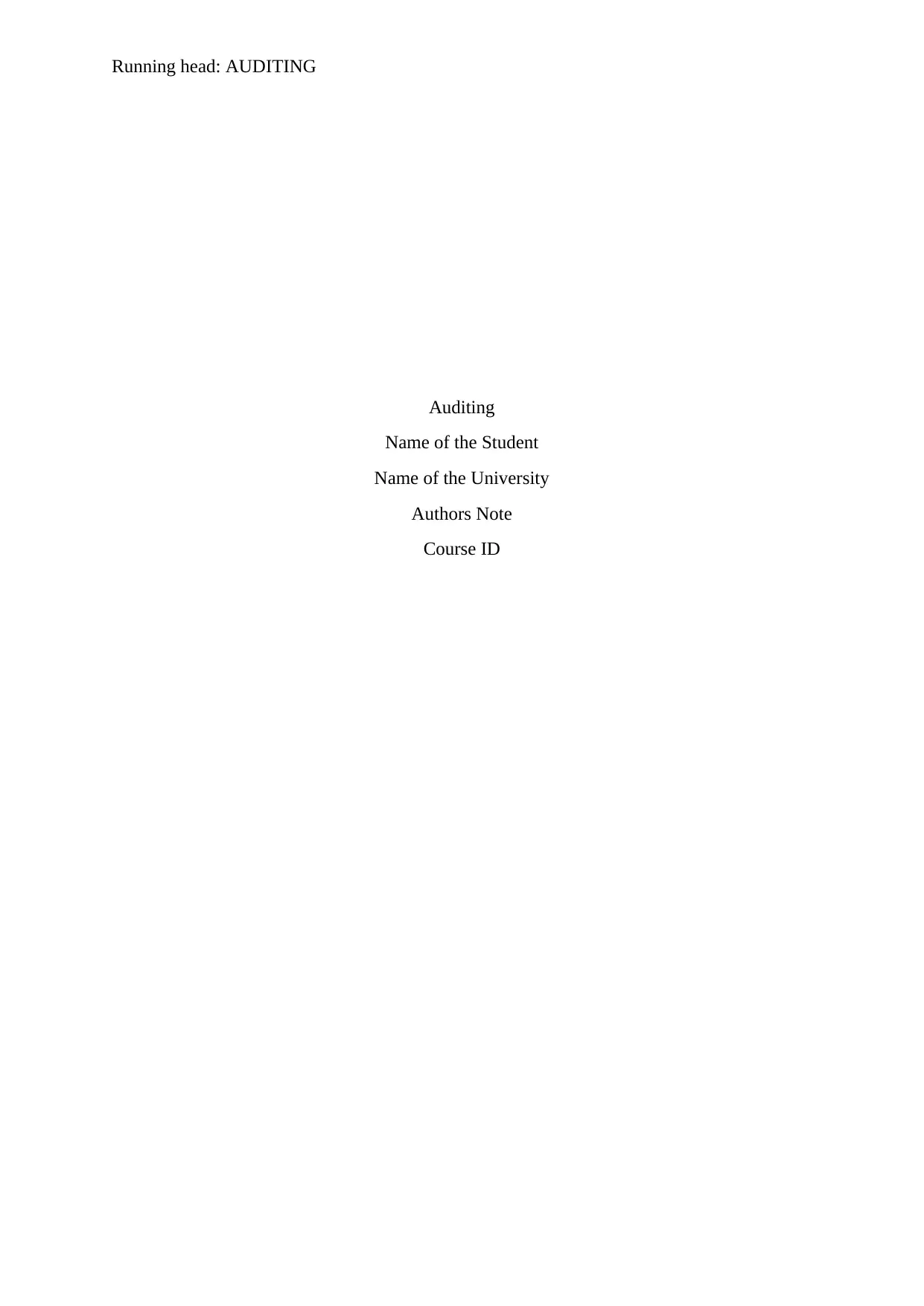
Running head: AUDITING
Auditing
Name of the Student
Name of the University
Authors Note
Course ID
Auditing
Name of the Student
Name of the University
Authors Note
Course ID
Secure Best Marks with AI Grader
Need help grading? Try our AI Grader for instant feedback on your assignments.
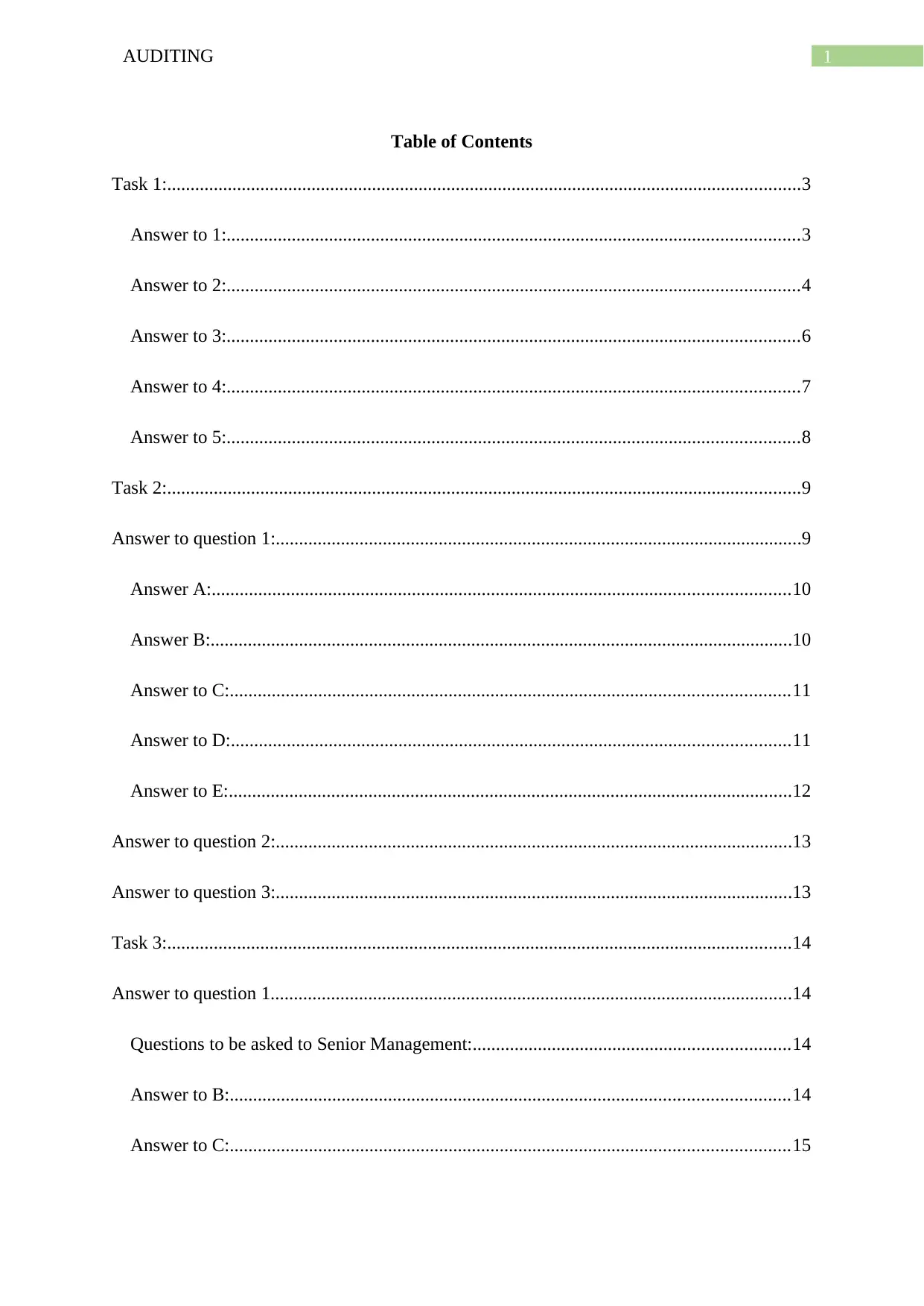
1AUDITING
Table of Contents
Task 1:........................................................................................................................................3
Answer to 1:...........................................................................................................................3
Answer to 2:...........................................................................................................................4
Answer to 3:...........................................................................................................................6
Answer to 4:...........................................................................................................................7
Answer to 5:...........................................................................................................................8
Task 2:........................................................................................................................................9
Answer to question 1:.................................................................................................................9
Answer A:............................................................................................................................10
Answer B:.............................................................................................................................10
Answer to C:........................................................................................................................11
Answer to D:........................................................................................................................11
Answer to E:.........................................................................................................................12
Answer to question 2:...............................................................................................................13
Answer to question 3:...............................................................................................................13
Task 3:......................................................................................................................................14
Answer to question 1................................................................................................................14
Questions to be asked to Senior Management:....................................................................14
Answer to B:........................................................................................................................14
Answer to C:........................................................................................................................15
Table of Contents
Task 1:........................................................................................................................................3
Answer to 1:...........................................................................................................................3
Answer to 2:...........................................................................................................................4
Answer to 3:...........................................................................................................................6
Answer to 4:...........................................................................................................................7
Answer to 5:...........................................................................................................................8
Task 2:........................................................................................................................................9
Answer to question 1:.................................................................................................................9
Answer A:............................................................................................................................10
Answer B:.............................................................................................................................10
Answer to C:........................................................................................................................11
Answer to D:........................................................................................................................11
Answer to E:.........................................................................................................................12
Answer to question 2:...............................................................................................................13
Answer to question 3:...............................................................................................................13
Task 3:......................................................................................................................................14
Answer to question 1................................................................................................................14
Questions to be asked to Senior Management:....................................................................14
Answer to B:........................................................................................................................14
Answer to C:........................................................................................................................15
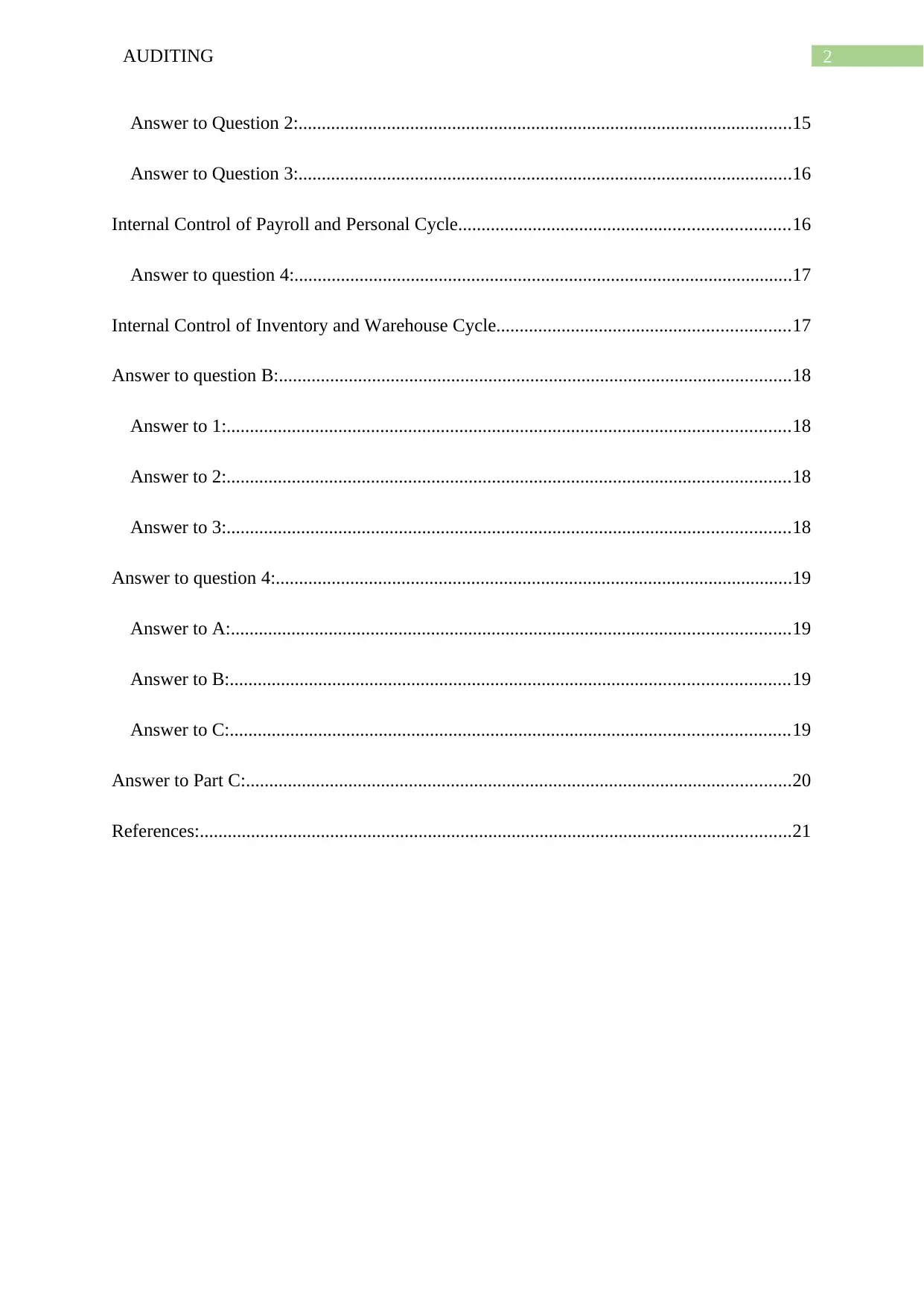
2AUDITING
Answer to Question 2:..........................................................................................................15
Answer to Question 3:..........................................................................................................16
Internal Control of Payroll and Personal Cycle.......................................................................16
Answer to question 4:...........................................................................................................17
Internal Control of Inventory and Warehouse Cycle...............................................................17
Answer to question B:..............................................................................................................18
Answer to 1:.........................................................................................................................18
Answer to 2:.........................................................................................................................18
Answer to 3:.........................................................................................................................18
Answer to question 4:...............................................................................................................19
Answer to A:........................................................................................................................19
Answer to B:........................................................................................................................19
Answer to C:........................................................................................................................19
Answer to Part C:.....................................................................................................................20
References:...............................................................................................................................21
Answer to Question 2:..........................................................................................................15
Answer to Question 3:..........................................................................................................16
Internal Control of Payroll and Personal Cycle.......................................................................16
Answer to question 4:...........................................................................................................17
Internal Control of Inventory and Warehouse Cycle...............................................................17
Answer to question B:..............................................................................................................18
Answer to 1:.........................................................................................................................18
Answer to 2:.........................................................................................................................18
Answer to 3:.........................................................................................................................18
Answer to question 4:...............................................................................................................19
Answer to A:........................................................................................................................19
Answer to B:........................................................................................................................19
Answer to C:........................................................................................................................19
Answer to Part C:.....................................................................................................................20
References:...............................................................................................................................21
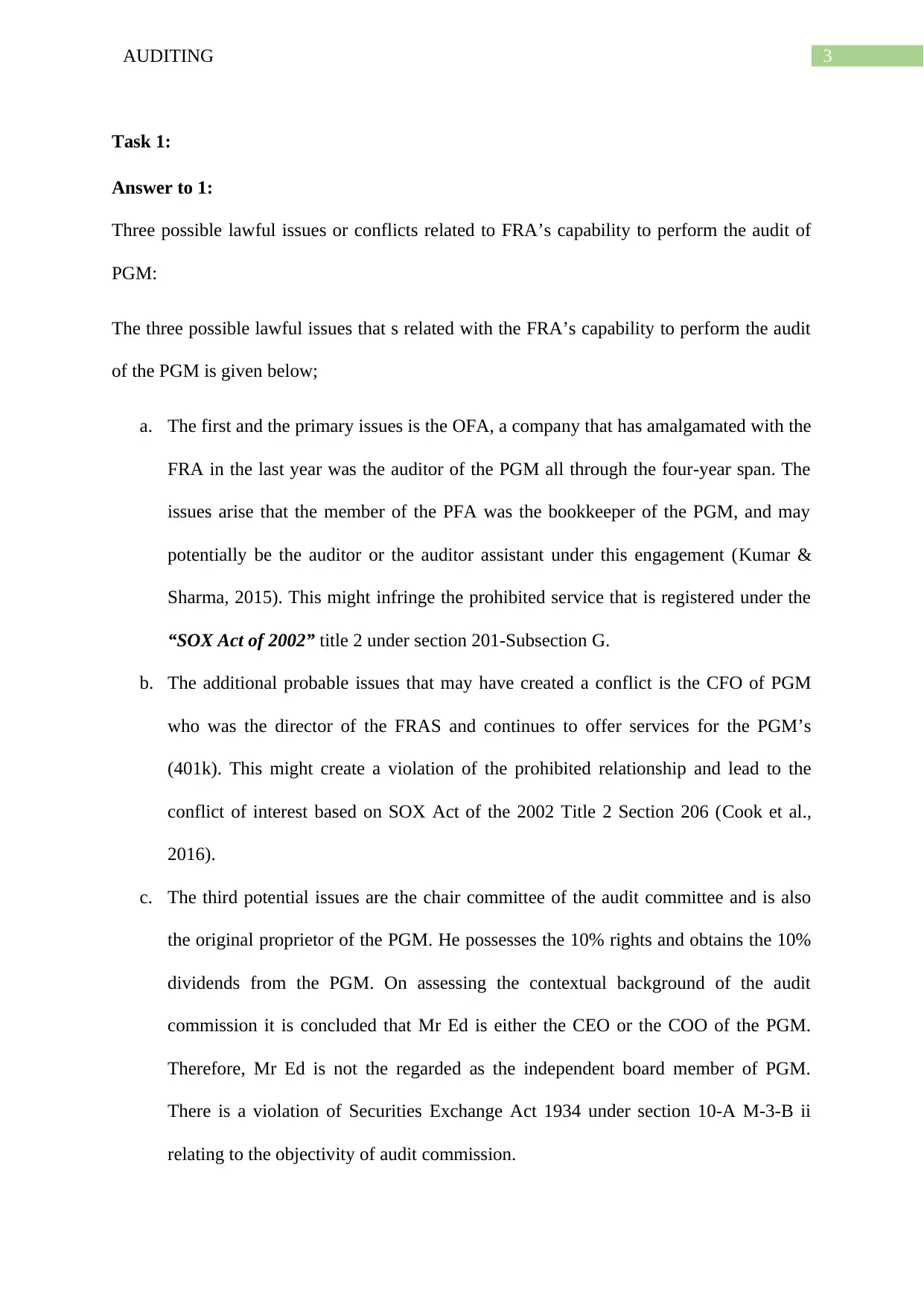
3AUDITING
Task 1:
Answer to 1:
Three possible lawful issues or conflicts related to FRA’s capability to perform the audit of
PGM:
The three possible lawful issues that s related with the FRA’s capability to perform the audit
of the PGM is given below;
a. The first and the primary issues is the OFA, a company that has amalgamated with the
FRA in the last year was the auditor of the PGM all through the four-year span. The
issues arise that the member of the PFA was the bookkeeper of the PGM, and may
potentially be the auditor or the auditor assistant under this engagement (Kumar &
Sharma, 2015). This might infringe the prohibited service that is registered under the
“SOX Act of 2002” title 2 under section 201-Subsection G.
b. The additional probable issues that may have created a conflict is the CFO of PGM
who was the director of the FRAS and continues to offer services for the PGM’s
(401k). This might create a violation of the prohibited relationship and lead to the
conflict of interest based on SOX Act of the 2002 Title 2 Section 206 (Cook et al.,
2016).
c. The third potential issues are the chair committee of the audit committee and is also
the original proprietor of the PGM. He possesses the 10% rights and obtains the 10%
dividends from the PGM. On assessing the contextual background of the audit
commission it is concluded that Mr Ed is either the CEO or the COO of the PGM.
Therefore, Mr Ed is not the regarded as the independent board member of PGM.
There is a violation of Securities Exchange Act 1934 under section 10-A M-3-B ii
relating to the objectivity of audit commission.
Task 1:
Answer to 1:
Three possible lawful issues or conflicts related to FRA’s capability to perform the audit of
PGM:
The three possible lawful issues that s related with the FRA’s capability to perform the audit
of the PGM is given below;
a. The first and the primary issues is the OFA, a company that has amalgamated with the
FRA in the last year was the auditor of the PGM all through the four-year span. The
issues arise that the member of the PFA was the bookkeeper of the PGM, and may
potentially be the auditor or the auditor assistant under this engagement (Kumar &
Sharma, 2015). This might infringe the prohibited service that is registered under the
“SOX Act of 2002” title 2 under section 201-Subsection G.
b. The additional probable issues that may have created a conflict is the CFO of PGM
who was the director of the FRAS and continues to offer services for the PGM’s
(401k). This might create a violation of the prohibited relationship and lead to the
conflict of interest based on SOX Act of the 2002 Title 2 Section 206 (Cook et al.,
2016).
c. The third potential issues are the chair committee of the audit committee and is also
the original proprietor of the PGM. He possesses the 10% rights and obtains the 10%
dividends from the PGM. On assessing the contextual background of the audit
commission it is concluded that Mr Ed is either the CEO or the COO of the PGM.
Therefore, Mr Ed is not the regarded as the independent board member of PGM.
There is a violation of Securities Exchange Act 1934 under section 10-A M-3-B ii
relating to the objectivity of audit commission.
Paraphrase This Document
Need a fresh take? Get an instant paraphrase of this document with our AI Paraphraser
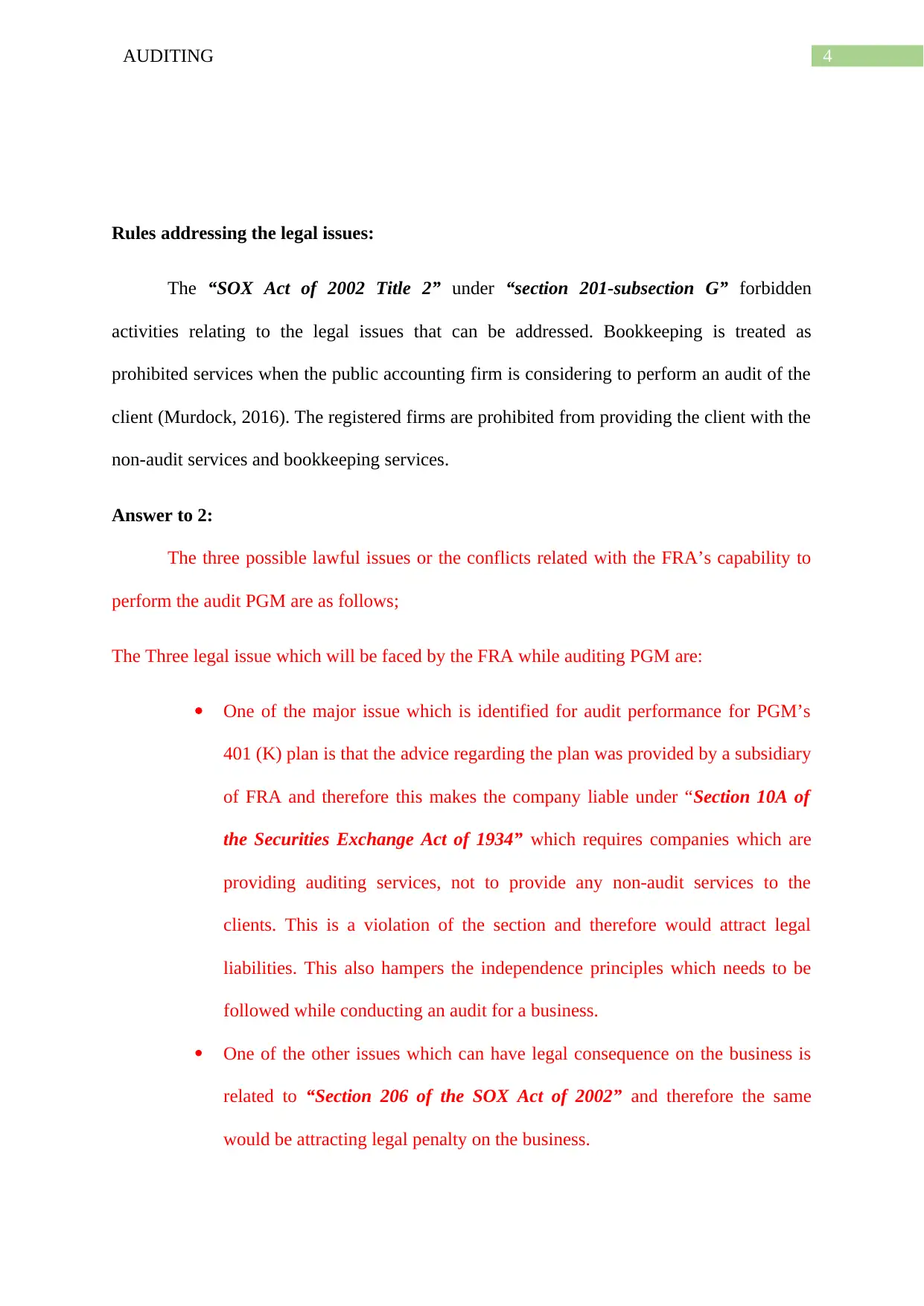
4AUDITING
Rules addressing the legal issues:
The “SOX Act of 2002 Title 2” under “section 201-subsection G” forbidden
activities relating to the legal issues that can be addressed. Bookkeeping is treated as
prohibited services when the public accounting firm is considering to perform an audit of the
client (Murdock, 2016). The registered firms are prohibited from providing the client with the
non-audit services and bookkeeping services.
Answer to 2:
The three possible lawful issues or the conflicts related with the FRA’s capability to
perform the audit PGM are as follows;
The Three legal issue which will be faced by the FRA while auditing PGM are:
One of the major issue which is identified for audit performance for PGM’s
401 (K) plan is that the advice regarding the plan was provided by a subsidiary
of FRA and therefore this makes the company liable under “Section 10A of
the Securities Exchange Act of 1934” which requires companies which are
providing auditing services, not to provide any non-audit services to the
clients. This is a violation of the section and therefore would attract legal
liabilities. This also hampers the independence principles which needs to be
followed while conducting an audit for a business.
One of the other issues which can have legal consequence on the business is
related to “Section 206 of the SOX Act of 2002” and therefore the same
would be attracting legal penalty on the business.
Rules addressing the legal issues:
The “SOX Act of 2002 Title 2” under “section 201-subsection G” forbidden
activities relating to the legal issues that can be addressed. Bookkeeping is treated as
prohibited services when the public accounting firm is considering to perform an audit of the
client (Murdock, 2016). The registered firms are prohibited from providing the client with the
non-audit services and bookkeeping services.
Answer to 2:
The three possible lawful issues or the conflicts related with the FRA’s capability to
perform the audit PGM are as follows;
The Three legal issue which will be faced by the FRA while auditing PGM are:
One of the major issue which is identified for audit performance for PGM’s
401 (K) plan is that the advice regarding the plan was provided by a subsidiary
of FRA and therefore this makes the company liable under “Section 10A of
the Securities Exchange Act of 1934” which requires companies which are
providing auditing services, not to provide any non-audit services to the
clients. This is a violation of the section and therefore would attract legal
liabilities. This also hampers the independence principles which needs to be
followed while conducting an audit for a business.
One of the other issues which can have legal consequence on the business is
related to “Section 206 of the SOX Act of 2002” and therefore the same
would be attracting legal penalty on the business.
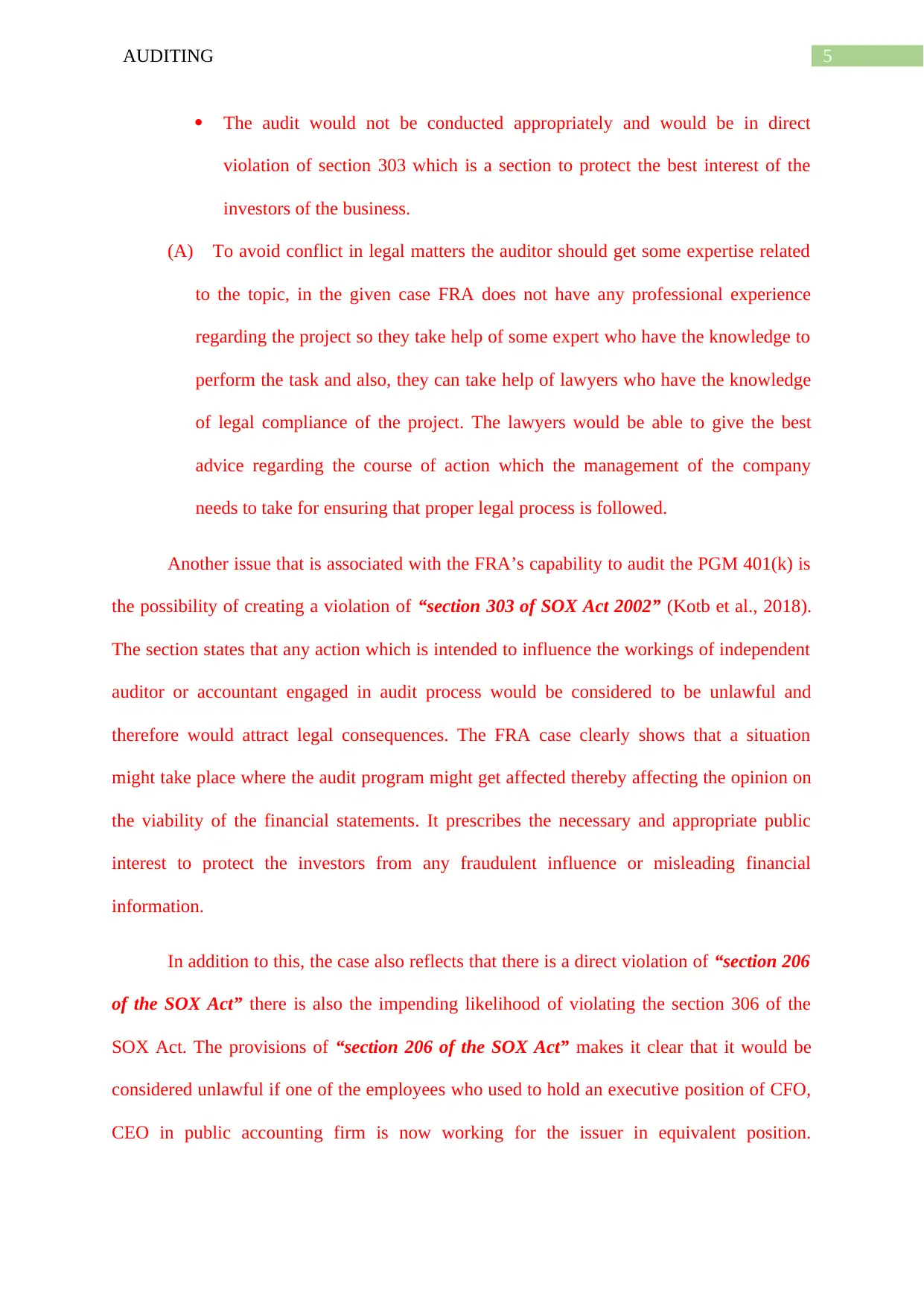
5AUDITING
The audit would not be conducted appropriately and would be in direct
violation of section 303 which is a section to protect the best interest of the
investors of the business.
(A) To avoid conflict in legal matters the auditor should get some expertise related
to the topic, in the given case FRA does not have any professional experience
regarding the project so they take help of some expert who have the knowledge to
perform the task and also, they can take help of lawyers who have the knowledge
of legal compliance of the project. The lawyers would be able to give the best
advice regarding the course of action which the management of the company
needs to take for ensuring that proper legal process is followed.
Another issue that is associated with the FRA’s capability to audit the PGM 401(k) is
the possibility of creating a violation of “section 303 of SOX Act 2002” (Kotb et al., 2018).
The section states that any action which is intended to influence the workings of independent
auditor or accountant engaged in audit process would be considered to be unlawful and
therefore would attract legal consequences. The FRA case clearly shows that a situation
might take place where the audit program might get affected thereby affecting the opinion on
the viability of the financial statements. It prescribes the necessary and appropriate public
interest to protect the investors from any fraudulent influence or misleading financial
information.
In addition to this, the case also reflects that there is a direct violation of “section 206
of the SOX Act” there is also the impending likelihood of violating the section 306 of the
SOX Act. The provisions of “section 206 of the SOX Act” makes it clear that it would be
considered unlawful if one of the employees who used to hold an executive position of CFO,
CEO in public accounting firm is now working for the issuer in equivalent position.
The audit would not be conducted appropriately and would be in direct
violation of section 303 which is a section to protect the best interest of the
investors of the business.
(A) To avoid conflict in legal matters the auditor should get some expertise related
to the topic, in the given case FRA does not have any professional experience
regarding the project so they take help of some expert who have the knowledge to
perform the task and also, they can take help of lawyers who have the knowledge
of legal compliance of the project. The lawyers would be able to give the best
advice regarding the course of action which the management of the company
needs to take for ensuring that proper legal process is followed.
Another issue that is associated with the FRA’s capability to audit the PGM 401(k) is
the possibility of creating a violation of “section 303 of SOX Act 2002” (Kotb et al., 2018).
The section states that any action which is intended to influence the workings of independent
auditor or accountant engaged in audit process would be considered to be unlawful and
therefore would attract legal consequences. The FRA case clearly shows that a situation
might take place where the audit program might get affected thereby affecting the opinion on
the viability of the financial statements. It prescribes the necessary and appropriate public
interest to protect the investors from any fraudulent influence or misleading financial
information.
In addition to this, the case also reflects that there is a direct violation of “section 206
of the SOX Act” there is also the impending likelihood of violating the section 306 of the
SOX Act. The provisions of “section 206 of the SOX Act” makes it clear that it would be
considered unlawful if one of the employees who used to hold an executive position of CFO,
CEO in public accounting firm is now working for the issuer in equivalent position.
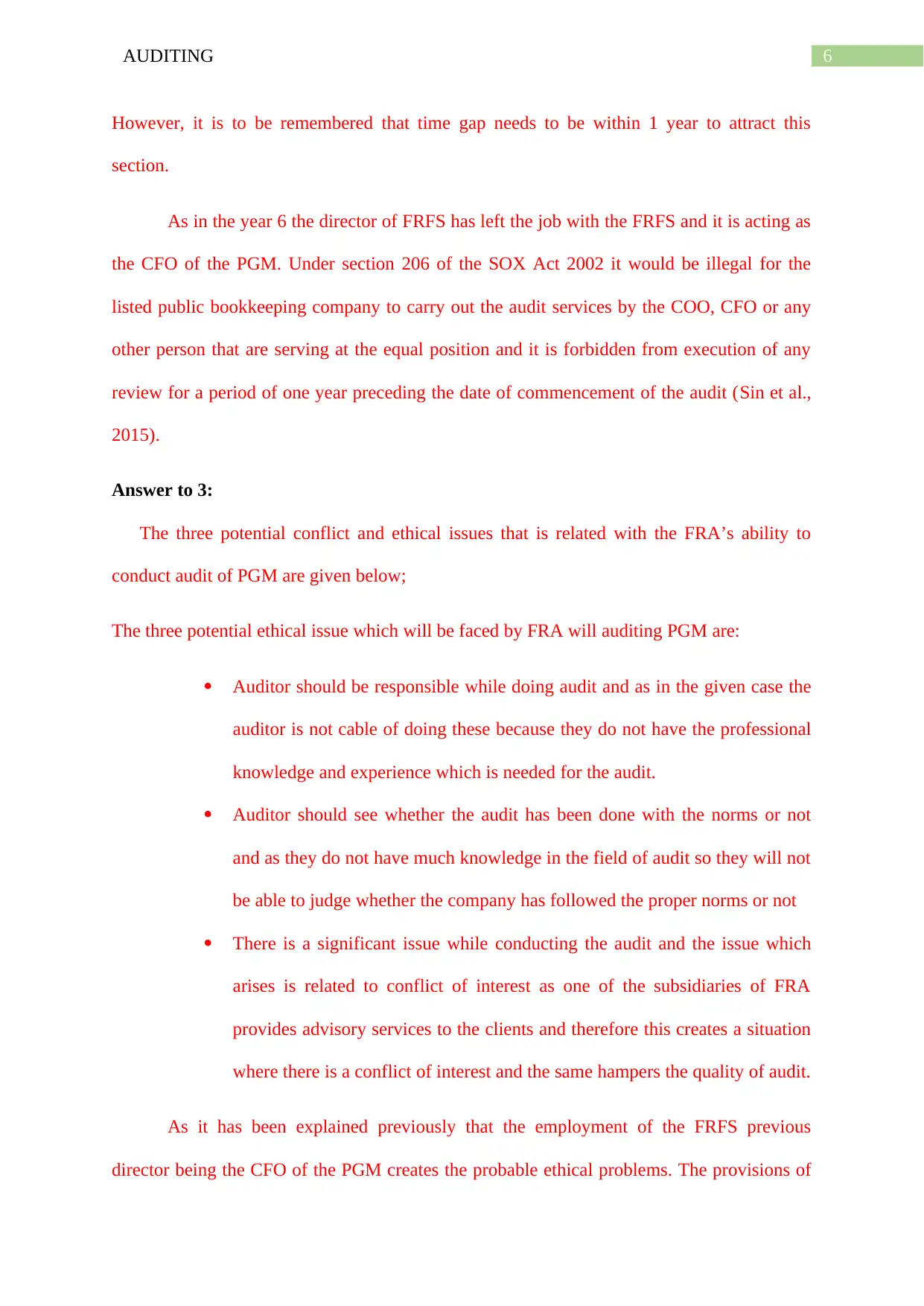
6AUDITING
However, it is to be remembered that time gap needs to be within 1 year to attract this
section.
As in the year 6 the director of FRFS has left the job with the FRFS and it is acting as
the CFO of the PGM. Under section 206 of the SOX Act 2002 it would be illegal for the
listed public bookkeeping company to carry out the audit services by the COO, CFO or any
other person that are serving at the equal position and it is forbidden from execution of any
review for a period of one year preceding the date of commencement of the audit (Sin et al.,
2015).
Answer to 3:
The three potential conflict and ethical issues that is related with the FRA’s ability to
conduct audit of PGM are given below;
The three potential ethical issue which will be faced by FRA will auditing PGM are:
Auditor should be responsible while doing audit and as in the given case the
auditor is not cable of doing these because they do not have the professional
knowledge and experience which is needed for the audit.
Auditor should see whether the audit has been done with the norms or not
and as they do not have much knowledge in the field of audit so they will not
be able to judge whether the company has followed the proper norms or not
There is a significant issue while conducting the audit and the issue which
arises is related to conflict of interest as one of the subsidiaries of FRA
provides advisory services to the clients and therefore this creates a situation
where there is a conflict of interest and the same hampers the quality of audit.
As it has been explained previously that the employment of the FRFS previous
director being the CFO of the PGM creates the probable ethical problems. The provisions of
However, it is to be remembered that time gap needs to be within 1 year to attract this
section.
As in the year 6 the director of FRFS has left the job with the FRFS and it is acting as
the CFO of the PGM. Under section 206 of the SOX Act 2002 it would be illegal for the
listed public bookkeeping company to carry out the audit services by the COO, CFO or any
other person that are serving at the equal position and it is forbidden from execution of any
review for a period of one year preceding the date of commencement of the audit (Sin et al.,
2015).
Answer to 3:
The three potential conflict and ethical issues that is related with the FRA’s ability to
conduct audit of PGM are given below;
The three potential ethical issue which will be faced by FRA will auditing PGM are:
Auditor should be responsible while doing audit and as in the given case the
auditor is not cable of doing these because they do not have the professional
knowledge and experience which is needed for the audit.
Auditor should see whether the audit has been done with the norms or not
and as they do not have much knowledge in the field of audit so they will not
be able to judge whether the company has followed the proper norms or not
There is a significant issue while conducting the audit and the issue which
arises is related to conflict of interest as one of the subsidiaries of FRA
provides advisory services to the clients and therefore this creates a situation
where there is a conflict of interest and the same hampers the quality of audit.
As it has been explained previously that the employment of the FRFS previous
director being the CFO of the PGM creates the probable ethical problems. The provisions of
Secure Best Marks with AI Grader
Need help grading? Try our AI Grader for instant feedback on your assignments.
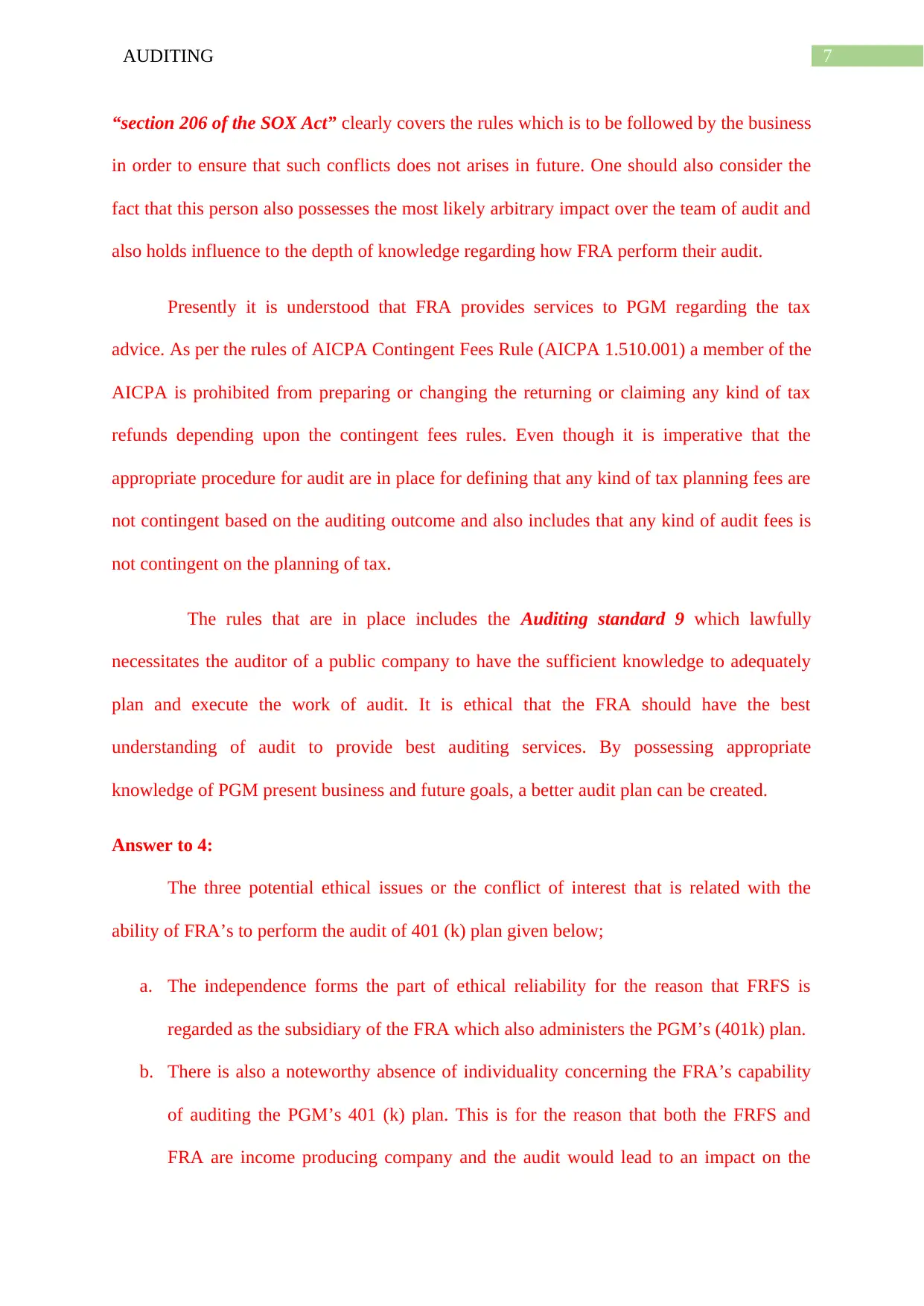
7AUDITING
“section 206 of the SOX Act” clearly covers the rules which is to be followed by the business
in order to ensure that such conflicts does not arises in future. One should also consider the
fact that this person also possesses the most likely arbitrary impact over the team of audit and
also holds influence to the depth of knowledge regarding how FRA perform their audit.
Presently it is understood that FRA provides services to PGM regarding the tax
advice. As per the rules of AICPA Contingent Fees Rule (AICPA 1.510.001) a member of the
AICPA is prohibited from preparing or changing the returning or claiming any kind of tax
refunds depending upon the contingent fees rules. Even though it is imperative that the
appropriate procedure for audit are in place for defining that any kind of tax planning fees are
not contingent based on the auditing outcome and also includes that any kind of audit fees is
not contingent on the planning of tax.
The rules that are in place includes the Auditing standard 9 which lawfully
necessitates the auditor of a public company to have the sufficient knowledge to adequately
plan and execute the work of audit. It is ethical that the FRA should have the best
understanding of audit to provide best auditing services. By possessing appropriate
knowledge of PGM present business and future goals, a better audit plan can be created.
Answer to 4:
The three potential ethical issues or the conflict of interest that is related with the
ability of FRA’s to perform the audit of 401 (k) plan given below;
a. The independence forms the part of ethical reliability for the reason that FRFS is
regarded as the subsidiary of the FRA which also administers the PGM’s (401k) plan.
b. There is also a noteworthy absence of individuality concerning the FRA’s capability
of auditing the PGM’s 401 (k) plan. This is for the reason that both the FRFS and
FRA are income producing company and the audit would lead to an impact on the
“section 206 of the SOX Act” clearly covers the rules which is to be followed by the business
in order to ensure that such conflicts does not arises in future. One should also consider the
fact that this person also possesses the most likely arbitrary impact over the team of audit and
also holds influence to the depth of knowledge regarding how FRA perform their audit.
Presently it is understood that FRA provides services to PGM regarding the tax
advice. As per the rules of AICPA Contingent Fees Rule (AICPA 1.510.001) a member of the
AICPA is prohibited from preparing or changing the returning or claiming any kind of tax
refunds depending upon the contingent fees rules. Even though it is imperative that the
appropriate procedure for audit are in place for defining that any kind of tax planning fees are
not contingent based on the auditing outcome and also includes that any kind of audit fees is
not contingent on the planning of tax.
The rules that are in place includes the Auditing standard 9 which lawfully
necessitates the auditor of a public company to have the sufficient knowledge to adequately
plan and execute the work of audit. It is ethical that the FRA should have the best
understanding of audit to provide best auditing services. By possessing appropriate
knowledge of PGM present business and future goals, a better audit plan can be created.
Answer to 4:
The three potential ethical issues or the conflict of interest that is related with the
ability of FRA’s to perform the audit of 401 (k) plan given below;
a. The independence forms the part of ethical reliability for the reason that FRFS is
regarded as the subsidiary of the FRA which also administers the PGM’s (401k) plan.
b. There is also a noteworthy absence of individuality concerning the FRA’s capability
of auditing the PGM’s 401 (k) plan. This is for the reason that both the FRFS and
FRA are income producing company and the audit would lead to an impact on the
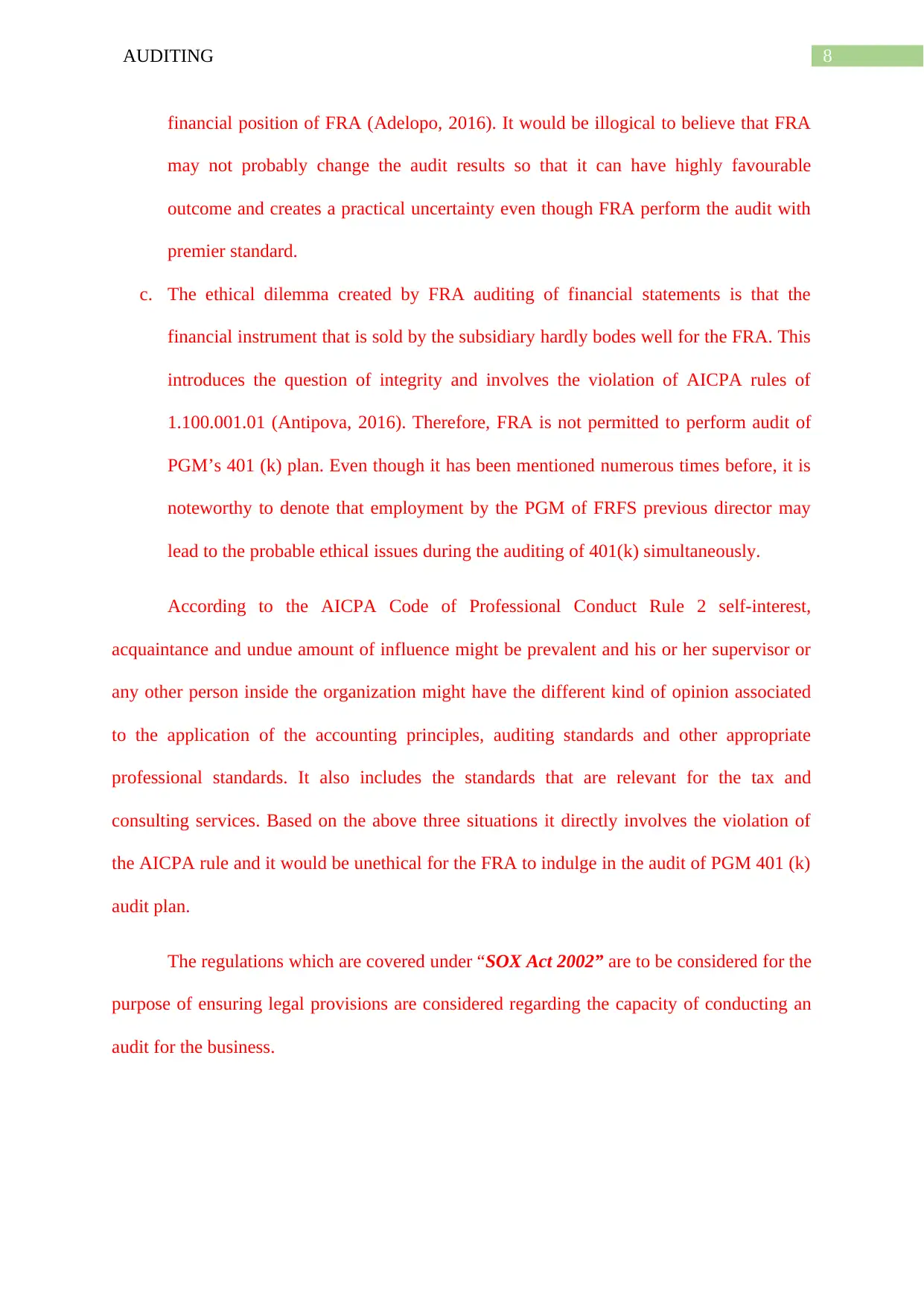
8AUDITING
financial position of FRA (Adelopo, 2016). It would be illogical to believe that FRA
may not probably change the audit results so that it can have highly favourable
outcome and creates a practical uncertainty even though FRA perform the audit with
premier standard.
c. The ethical dilemma created by FRA auditing of financial statements is that the
financial instrument that is sold by the subsidiary hardly bodes well for the FRA. This
introduces the question of integrity and involves the violation of AICPA rules of
1.100.001.01 (Antipova, 2016). Therefore, FRA is not permitted to perform audit of
PGM’s 401 (k) plan. Even though it has been mentioned numerous times before, it is
noteworthy to denote that employment by the PGM of FRFS previous director may
lead to the probable ethical issues during the auditing of 401(k) simultaneously.
According to the AICPA Code of Professional Conduct Rule 2 self-interest,
acquaintance and undue amount of influence might be prevalent and his or her supervisor or
any other person inside the organization might have the different kind of opinion associated
to the application of the accounting principles, auditing standards and other appropriate
professional standards. It also includes the standards that are relevant for the tax and
consulting services. Based on the above three situations it directly involves the violation of
the AICPA rule and it would be unethical for the FRA to indulge in the audit of PGM 401 (k)
audit plan.
The regulations which are covered under “SOX Act 2002” are to be considered for the
purpose of ensuring legal provisions are considered regarding the capacity of conducting an
audit for the business.
financial position of FRA (Adelopo, 2016). It would be illogical to believe that FRA
may not probably change the audit results so that it can have highly favourable
outcome and creates a practical uncertainty even though FRA perform the audit with
premier standard.
c. The ethical dilemma created by FRA auditing of financial statements is that the
financial instrument that is sold by the subsidiary hardly bodes well for the FRA. This
introduces the question of integrity and involves the violation of AICPA rules of
1.100.001.01 (Antipova, 2016). Therefore, FRA is not permitted to perform audit of
PGM’s 401 (k) plan. Even though it has been mentioned numerous times before, it is
noteworthy to denote that employment by the PGM of FRFS previous director may
lead to the probable ethical issues during the auditing of 401(k) simultaneously.
According to the AICPA Code of Professional Conduct Rule 2 self-interest,
acquaintance and undue amount of influence might be prevalent and his or her supervisor or
any other person inside the organization might have the different kind of opinion associated
to the application of the accounting principles, auditing standards and other appropriate
professional standards. It also includes the standards that are relevant for the tax and
consulting services. Based on the above three situations it directly involves the violation of
the AICPA rule and it would be unethical for the FRA to indulge in the audit of PGM 401 (k)
audit plan.
The regulations which are covered under “SOX Act 2002” are to be considered for the
purpose of ensuring legal provisions are considered regarding the capacity of conducting an
audit for the business.
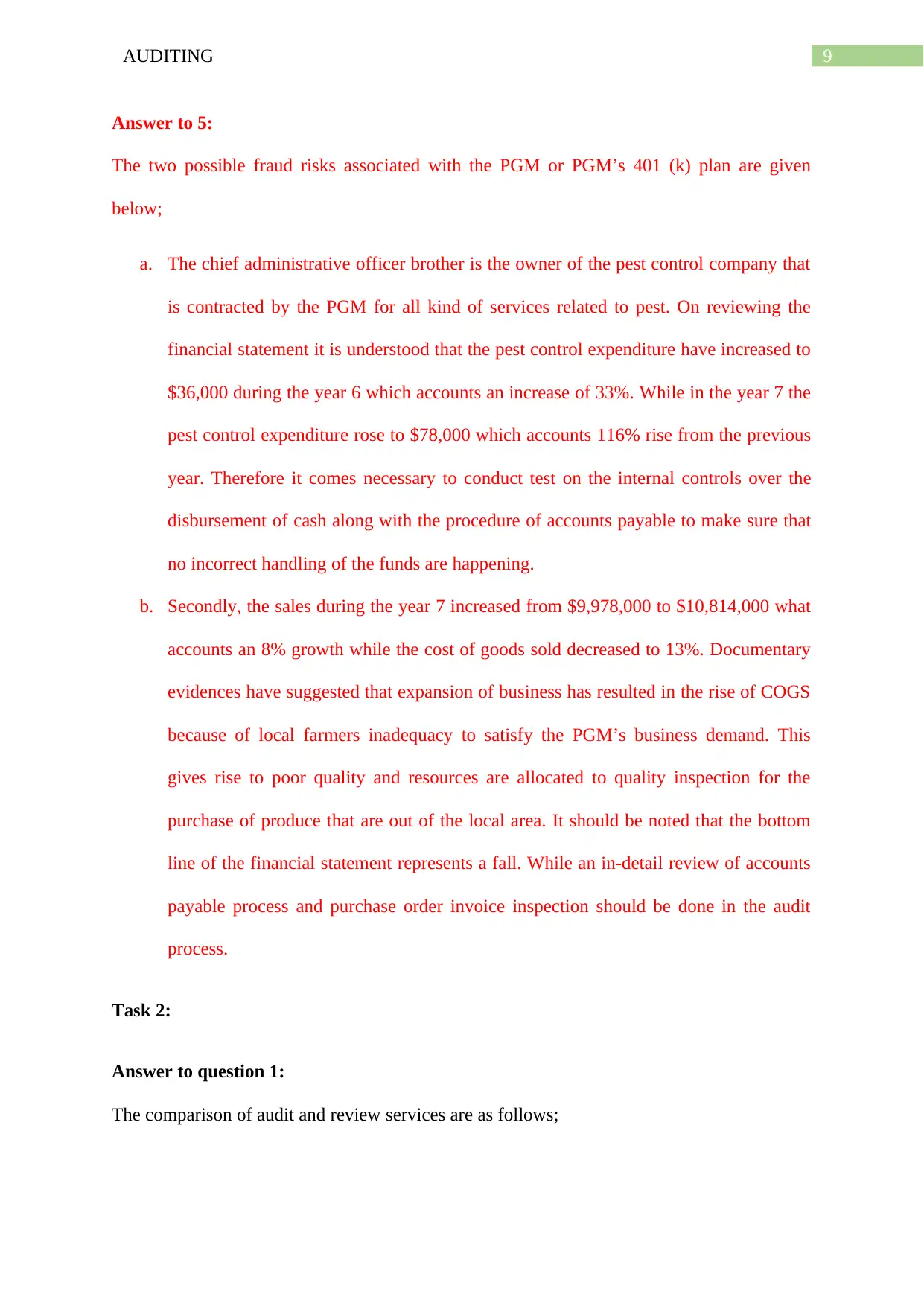
9AUDITING
Answer to 5:
The two possible fraud risks associated with the PGM or PGM’s 401 (k) plan are given
below;
a. The chief administrative officer brother is the owner of the pest control company that
is contracted by the PGM for all kind of services related to pest. On reviewing the
financial statement it is understood that the pest control expenditure have increased to
$36,000 during the year 6 which accounts an increase of 33%. While in the year 7 the
pest control expenditure rose to $78,000 which accounts 116% rise from the previous
year. Therefore it comes necessary to conduct test on the internal controls over the
disbursement of cash along with the procedure of accounts payable to make sure that
no incorrect handling of the funds are happening.
b. Secondly, the sales during the year 7 increased from $9,978,000 to $10,814,000 what
accounts an 8% growth while the cost of goods sold decreased to 13%. Documentary
evidences have suggested that expansion of business has resulted in the rise of COGS
because of local farmers inadequacy to satisfy the PGM’s business demand. This
gives rise to poor quality and resources are allocated to quality inspection for the
purchase of produce that are out of the local area. It should be noted that the bottom
line of the financial statement represents a fall. While an in-detail review of accounts
payable process and purchase order invoice inspection should be done in the audit
process.
Task 2:
Answer to question 1:
The comparison of audit and review services are as follows;
Answer to 5:
The two possible fraud risks associated with the PGM or PGM’s 401 (k) plan are given
below;
a. The chief administrative officer brother is the owner of the pest control company that
is contracted by the PGM for all kind of services related to pest. On reviewing the
financial statement it is understood that the pest control expenditure have increased to
$36,000 during the year 6 which accounts an increase of 33%. While in the year 7 the
pest control expenditure rose to $78,000 which accounts 116% rise from the previous
year. Therefore it comes necessary to conduct test on the internal controls over the
disbursement of cash along with the procedure of accounts payable to make sure that
no incorrect handling of the funds are happening.
b. Secondly, the sales during the year 7 increased from $9,978,000 to $10,814,000 what
accounts an 8% growth while the cost of goods sold decreased to 13%. Documentary
evidences have suggested that expansion of business has resulted in the rise of COGS
because of local farmers inadequacy to satisfy the PGM’s business demand. This
gives rise to poor quality and resources are allocated to quality inspection for the
purchase of produce that are out of the local area. It should be noted that the bottom
line of the financial statement represents a fall. While an in-detail review of accounts
payable process and purchase order invoice inspection should be done in the audit
process.
Task 2:
Answer to question 1:
The comparison of audit and review services are as follows;
Paraphrase This Document
Need a fresh take? Get an instant paraphrase of this document with our AI Paraphraser
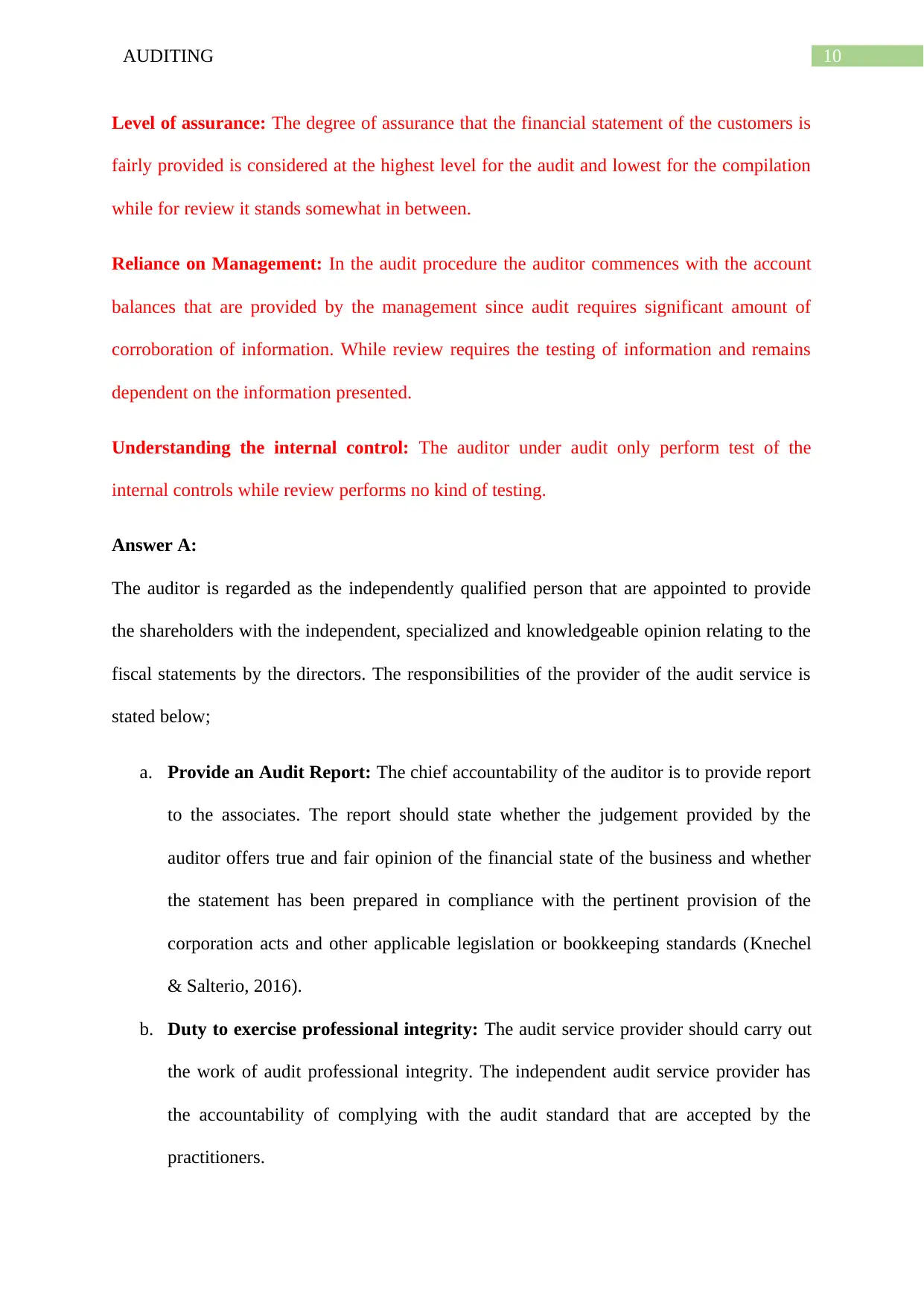
10AUDITING
Level of assurance: The degree of assurance that the financial statement of the customers is
fairly provided is considered at the highest level for the audit and lowest for the compilation
while for review it stands somewhat in between.
Reliance on Management: In the audit procedure the auditor commences with the account
balances that are provided by the management since audit requires significant amount of
corroboration of information. While review requires the testing of information and remains
dependent on the information presented.
Understanding the internal control: The auditor under audit only perform test of the
internal controls while review performs no kind of testing.
Answer A:
The auditor is regarded as the independently qualified person that are appointed to provide
the shareholders with the independent, specialized and knowledgeable opinion relating to the
fiscal statements by the directors. The responsibilities of the provider of the audit service is
stated below;
a. Provide an Audit Report: The chief accountability of the auditor is to provide report
to the associates. The report should state whether the judgement provided by the
auditor offers true and fair opinion of the financial state of the business and whether
the statement has been prepared in compliance with the pertinent provision of the
corporation acts and other applicable legislation or bookkeeping standards (Knechel
& Salterio, 2016).
b. Duty to exercise professional integrity: The audit service provider should carry out
the work of audit professional integrity. The independent audit service provider has
the accountability of complying with the audit standard that are accepted by the
practitioners.
Level of assurance: The degree of assurance that the financial statement of the customers is
fairly provided is considered at the highest level for the audit and lowest for the compilation
while for review it stands somewhat in between.
Reliance on Management: In the audit procedure the auditor commences with the account
balances that are provided by the management since audit requires significant amount of
corroboration of information. While review requires the testing of information and remains
dependent on the information presented.
Understanding the internal control: The auditor under audit only perform test of the
internal controls while review performs no kind of testing.
Answer A:
The auditor is regarded as the independently qualified person that are appointed to provide
the shareholders with the independent, specialized and knowledgeable opinion relating to the
fiscal statements by the directors. The responsibilities of the provider of the audit service is
stated below;
a. Provide an Audit Report: The chief accountability of the auditor is to provide report
to the associates. The report should state whether the judgement provided by the
auditor offers true and fair opinion of the financial state of the business and whether
the statement has been prepared in compliance with the pertinent provision of the
corporation acts and other applicable legislation or bookkeeping standards (Knechel
& Salterio, 2016).
b. Duty to exercise professional integrity: The audit service provider should carry out
the work of audit professional integrity. The independent audit service provider has
the accountability of complying with the audit standard that are accepted by the
practitioners.
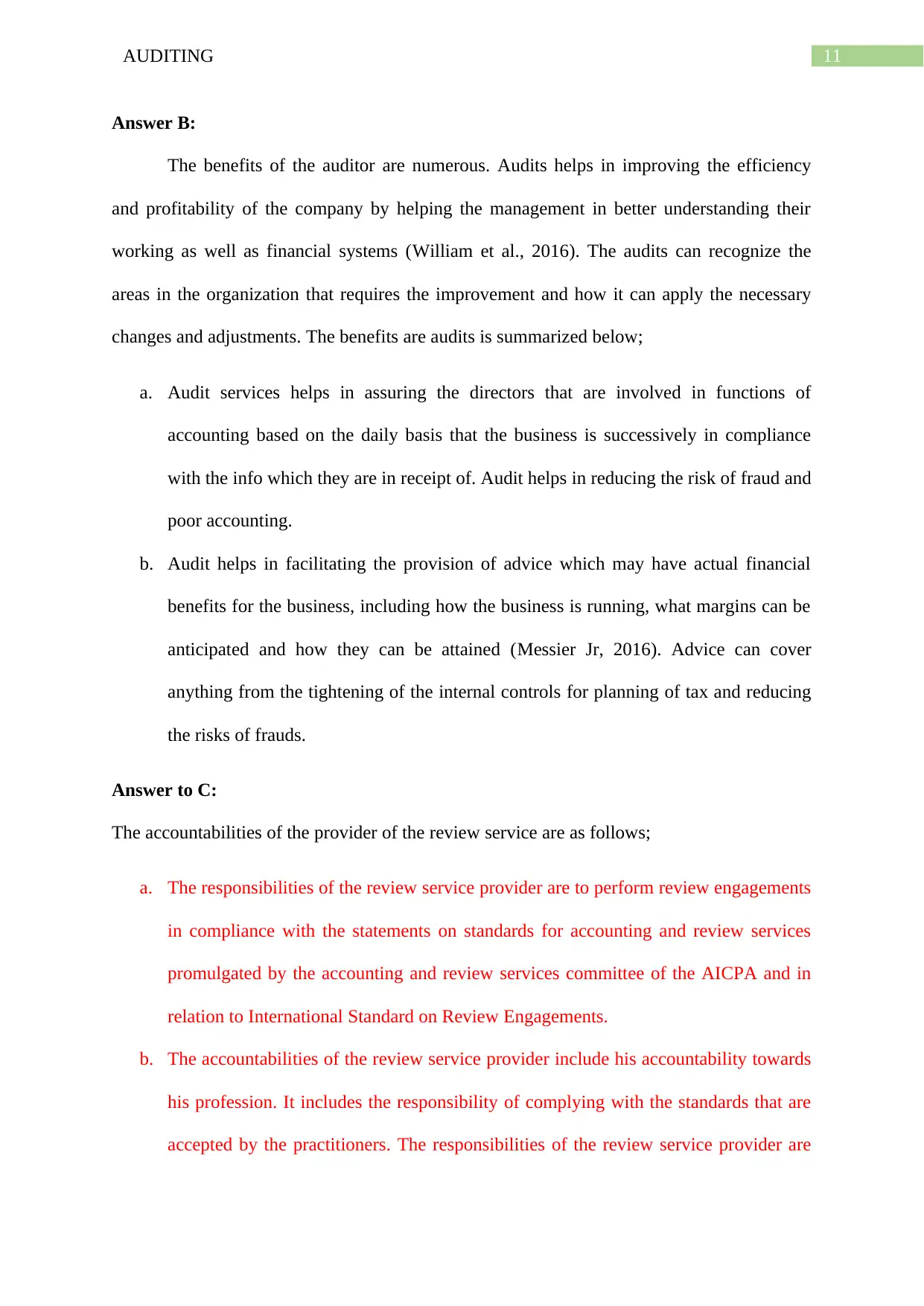
11AUDITING
Answer B:
The benefits of the auditor are numerous. Audits helps in improving the efficiency
and profitability of the company by helping the management in better understanding their
working as well as financial systems (William et al., 2016). The audits can recognize the
areas in the organization that requires the improvement and how it can apply the necessary
changes and adjustments. The benefits are audits is summarized below;
a. Audit services helps in assuring the directors that are involved in functions of
accounting based on the daily basis that the business is successively in compliance
with the info which they are in receipt of. Audit helps in reducing the risk of fraud and
poor accounting.
b. Audit helps in facilitating the provision of advice which may have actual financial
benefits for the business, including how the business is running, what margins can be
anticipated and how they can be attained (Messier Jr, 2016). Advice can cover
anything from the tightening of the internal controls for planning of tax and reducing
the risks of frauds.
Answer to C:
The accountabilities of the provider of the review service are as follows;
a. The responsibilities of the review service provider are to perform review engagements
in compliance with the statements on standards for accounting and review services
promulgated by the accounting and review services committee of the AICPA and in
relation to International Standard on Review Engagements.
b. The accountabilities of the review service provider include his accountability towards
his profession. It includes the responsibility of complying with the standards that are
accepted by the practitioners. The responsibilities of the review service provider are
Answer B:
The benefits of the auditor are numerous. Audits helps in improving the efficiency
and profitability of the company by helping the management in better understanding their
working as well as financial systems (William et al., 2016). The audits can recognize the
areas in the organization that requires the improvement and how it can apply the necessary
changes and adjustments. The benefits are audits is summarized below;
a. Audit services helps in assuring the directors that are involved in functions of
accounting based on the daily basis that the business is successively in compliance
with the info which they are in receipt of. Audit helps in reducing the risk of fraud and
poor accounting.
b. Audit helps in facilitating the provision of advice which may have actual financial
benefits for the business, including how the business is running, what margins can be
anticipated and how they can be attained (Messier Jr, 2016). Advice can cover
anything from the tightening of the internal controls for planning of tax and reducing
the risks of frauds.
Answer to C:
The accountabilities of the provider of the review service are as follows;
a. The responsibilities of the review service provider are to perform review engagements
in compliance with the statements on standards for accounting and review services
promulgated by the accounting and review services committee of the AICPA and in
relation to International Standard on Review Engagements.
b. The accountabilities of the review service provider include his accountability towards
his profession. It includes the responsibility of complying with the standards that are
accepted by the practitioners. The responsibilities of the review service provider are
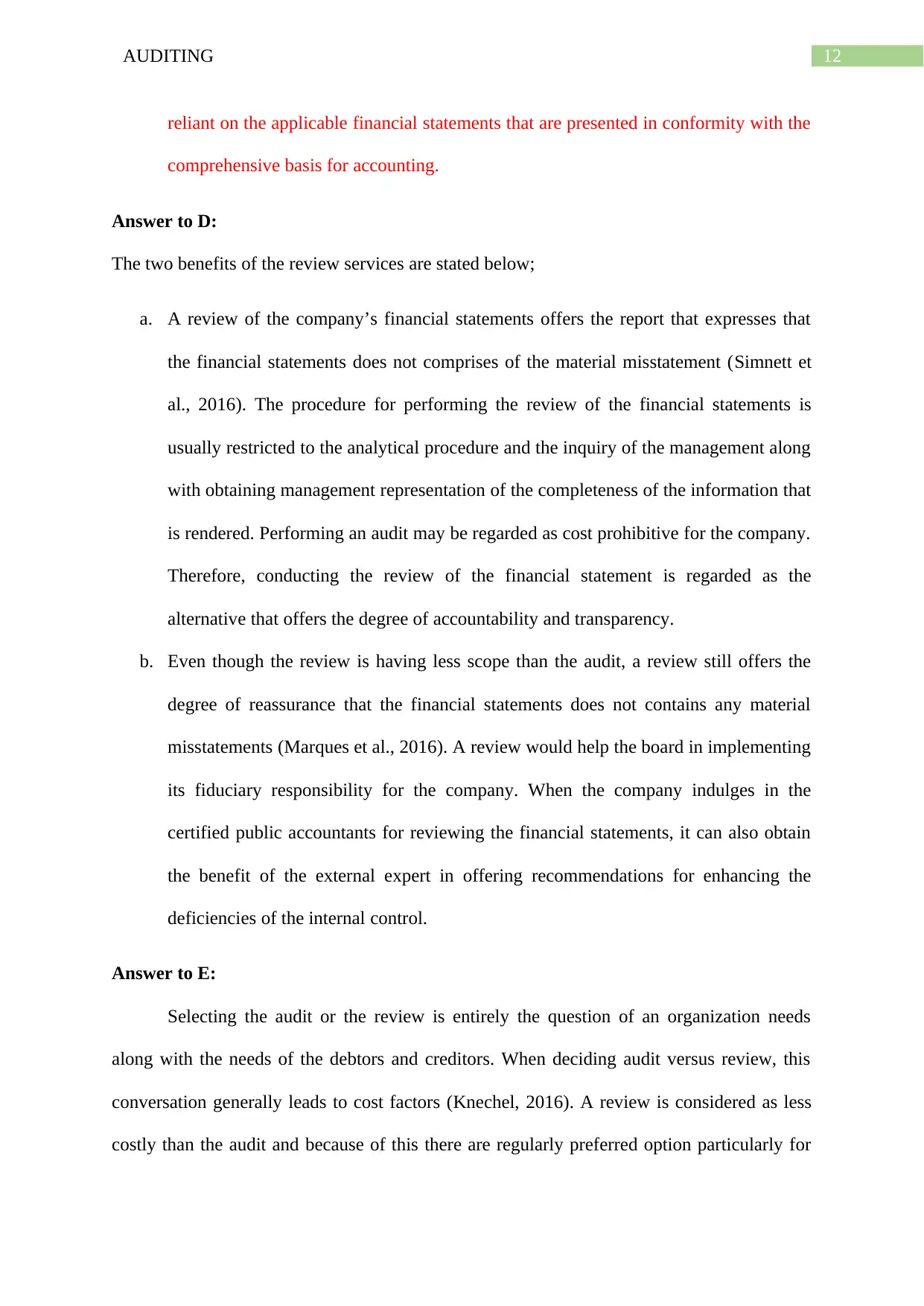
12AUDITING
reliant on the applicable financial statements that are presented in conformity with the
comprehensive basis for accounting.
Answer to D:
The two benefits of the review services are stated below;
a. A review of the company’s financial statements offers the report that expresses that
the financial statements does not comprises of the material misstatement (Simnett et
al., 2016). The procedure for performing the review of the financial statements is
usually restricted to the analytical procedure and the inquiry of the management along
with obtaining management representation of the completeness of the information that
is rendered. Performing an audit may be regarded as cost prohibitive for the company.
Therefore, conducting the review of the financial statement is regarded as the
alternative that offers the degree of accountability and transparency.
b. Even though the review is having less scope than the audit, a review still offers the
degree of reassurance that the financial statements does not contains any material
misstatements (Marques et al., 2016). A review would help the board in implementing
its fiduciary responsibility for the company. When the company indulges in the
certified public accountants for reviewing the financial statements, it can also obtain
the benefit of the external expert in offering recommendations for enhancing the
deficiencies of the internal control.
Answer to E:
Selecting the audit or the review is entirely the question of an organization needs
along with the needs of the debtors and creditors. When deciding audit versus review, this
conversation generally leads to cost factors (Knechel, 2016). A review is considered as less
costly than the audit and because of this there are regularly preferred option particularly for
reliant on the applicable financial statements that are presented in conformity with the
comprehensive basis for accounting.
Answer to D:
The two benefits of the review services are stated below;
a. A review of the company’s financial statements offers the report that expresses that
the financial statements does not comprises of the material misstatement (Simnett et
al., 2016). The procedure for performing the review of the financial statements is
usually restricted to the analytical procedure and the inquiry of the management along
with obtaining management representation of the completeness of the information that
is rendered. Performing an audit may be regarded as cost prohibitive for the company.
Therefore, conducting the review of the financial statement is regarded as the
alternative that offers the degree of accountability and transparency.
b. Even though the review is having less scope than the audit, a review still offers the
degree of reassurance that the financial statements does not contains any material
misstatements (Marques et al., 2016). A review would help the board in implementing
its fiduciary responsibility for the company. When the company indulges in the
certified public accountants for reviewing the financial statements, it can also obtain
the benefit of the external expert in offering recommendations for enhancing the
deficiencies of the internal control.
Answer to E:
Selecting the audit or the review is entirely the question of an organization needs
along with the needs of the debtors and creditors. When deciding audit versus review, this
conversation generally leads to cost factors (Knechel, 2016). A review is considered as less
costly than the audit and because of this there are regularly preferred option particularly for
Secure Best Marks with AI Grader
Need help grading? Try our AI Grader for instant feedback on your assignments.
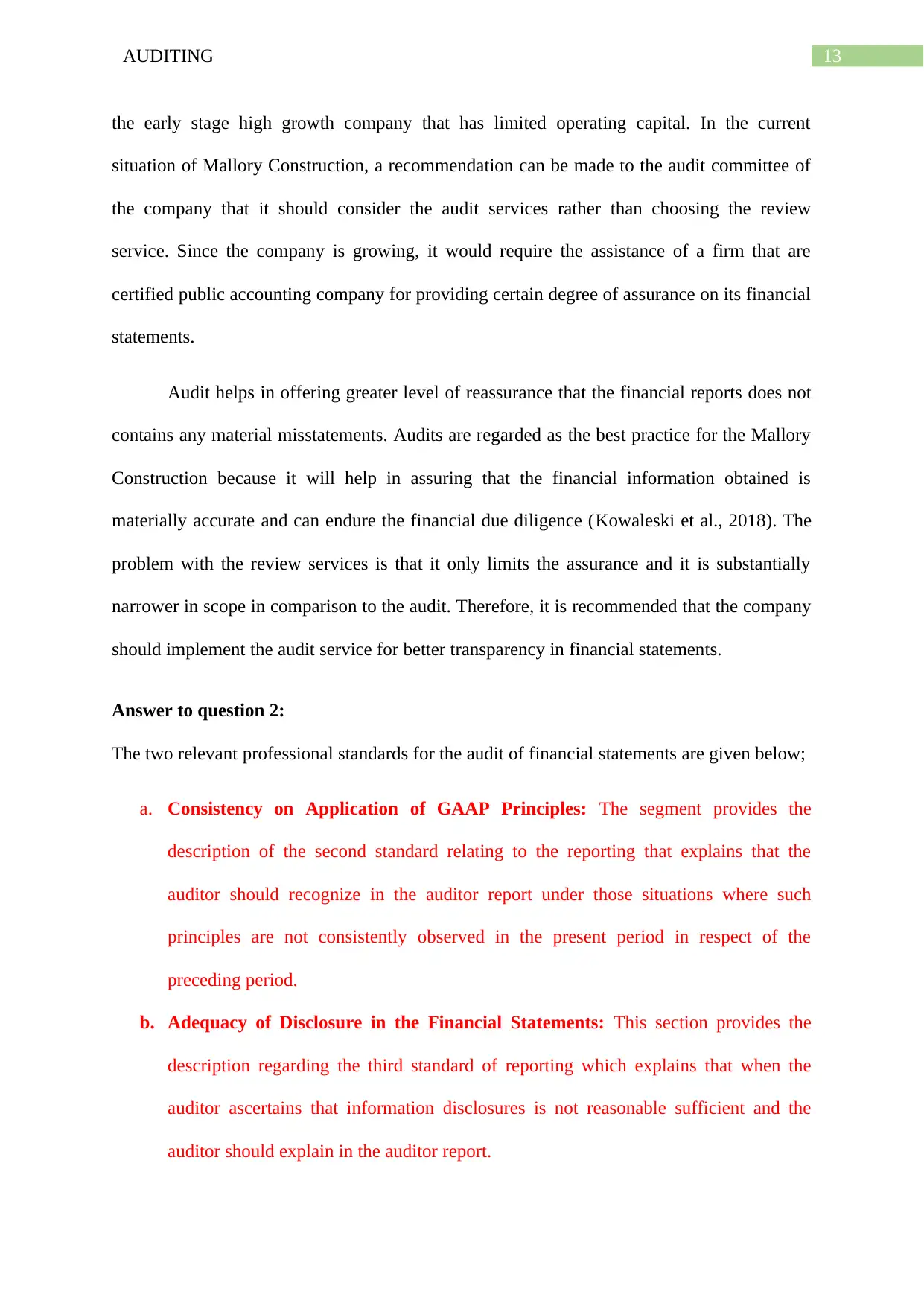
13AUDITING
the early stage high growth company that has limited operating capital. In the current
situation of Mallory Construction, a recommendation can be made to the audit committee of
the company that it should consider the audit services rather than choosing the review
service. Since the company is growing, it would require the assistance of a firm that are
certified public accounting company for providing certain degree of assurance on its financial
statements.
Audit helps in offering greater level of reassurance that the financial reports does not
contains any material misstatements. Audits are regarded as the best practice for the Mallory
Construction because it will help in assuring that the financial information obtained is
materially accurate and can endure the financial due diligence (Kowaleski et al., 2018). The
problem with the review services is that it only limits the assurance and it is substantially
narrower in scope in comparison to the audit. Therefore, it is recommended that the company
should implement the audit service for better transparency in financial statements.
Answer to question 2:
The two relevant professional standards for the audit of financial statements are given below;
a. Consistency on Application of GAAP Principles: The segment provides the
description of the second standard relating to the reporting that explains that the
auditor should recognize in the auditor report under those situations where such
principles are not consistently observed in the present period in respect of the
preceding period.
b. Adequacy of Disclosure in the Financial Statements: This section provides the
description regarding the third standard of reporting which explains that when the
auditor ascertains that information disclosures is not reasonable sufficient and the
auditor should explain in the auditor report.
the early stage high growth company that has limited operating capital. In the current
situation of Mallory Construction, a recommendation can be made to the audit committee of
the company that it should consider the audit services rather than choosing the review
service. Since the company is growing, it would require the assistance of a firm that are
certified public accounting company for providing certain degree of assurance on its financial
statements.
Audit helps in offering greater level of reassurance that the financial reports does not
contains any material misstatements. Audits are regarded as the best practice for the Mallory
Construction because it will help in assuring that the financial information obtained is
materially accurate and can endure the financial due diligence (Kowaleski et al., 2018). The
problem with the review services is that it only limits the assurance and it is substantially
narrower in scope in comparison to the audit. Therefore, it is recommended that the company
should implement the audit service for better transparency in financial statements.
Answer to question 2:
The two relevant professional standards for the audit of financial statements are given below;
a. Consistency on Application of GAAP Principles: The segment provides the
description of the second standard relating to the reporting that explains that the
auditor should recognize in the auditor report under those situations where such
principles are not consistently observed in the present period in respect of the
preceding period.
b. Adequacy of Disclosure in the Financial Statements: This section provides the
description regarding the third standard of reporting which explains that when the
auditor ascertains that information disclosures is not reasonable sufficient and the
auditor should explain in the auditor report.
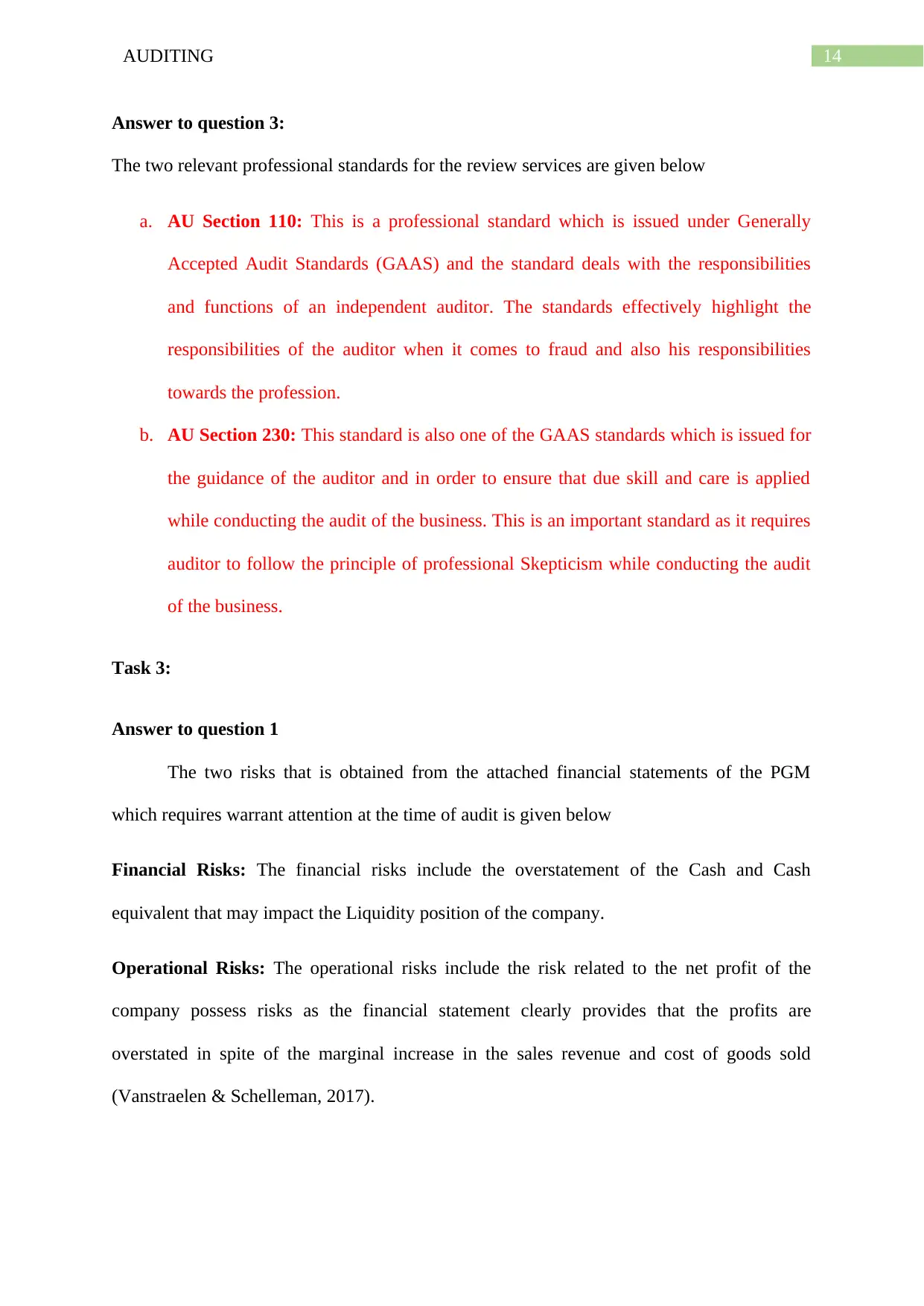
14AUDITING
Answer to question 3:
The two relevant professional standards for the review services are given below
a. AU Section 110: This is a professional standard which is issued under Generally
Accepted Audit Standards (GAAS) and the standard deals with the responsibilities
and functions of an independent auditor. The standards effectively highlight the
responsibilities of the auditor when it comes to fraud and also his responsibilities
towards the profession.
b. AU Section 230: This standard is also one of the GAAS standards which is issued for
the guidance of the auditor and in order to ensure that due skill and care is applied
while conducting the audit of the business. This is an important standard as it requires
auditor to follow the principle of professional Skepticism while conducting the audit
of the business.
Task 3:
Answer to question 1
The two risks that is obtained from the attached financial statements of the PGM
which requires warrant attention at the time of audit is given below
Financial Risks: The financial risks include the overstatement of the Cash and Cash
equivalent that may impact the Liquidity position of the company.
Operational Risks: The operational risks include the risk related to the net profit of the
company possess risks as the financial statement clearly provides that the profits are
overstated in spite of the marginal increase in the sales revenue and cost of goods sold
(Vanstraelen & Schelleman, 2017).
Answer to question 3:
The two relevant professional standards for the review services are given below
a. AU Section 110: This is a professional standard which is issued under Generally
Accepted Audit Standards (GAAS) and the standard deals with the responsibilities
and functions of an independent auditor. The standards effectively highlight the
responsibilities of the auditor when it comes to fraud and also his responsibilities
towards the profession.
b. AU Section 230: This standard is also one of the GAAS standards which is issued for
the guidance of the auditor and in order to ensure that due skill and care is applied
while conducting the audit of the business. This is an important standard as it requires
auditor to follow the principle of professional Skepticism while conducting the audit
of the business.
Task 3:
Answer to question 1
The two risks that is obtained from the attached financial statements of the PGM
which requires warrant attention at the time of audit is given below
Financial Risks: The financial risks include the overstatement of the Cash and Cash
equivalent that may impact the Liquidity position of the company.
Operational Risks: The operational risks include the risk related to the net profit of the
company possess risks as the financial statement clearly provides that the profits are
overstated in spite of the marginal increase in the sales revenue and cost of goods sold
(Vanstraelen & Schelleman, 2017).
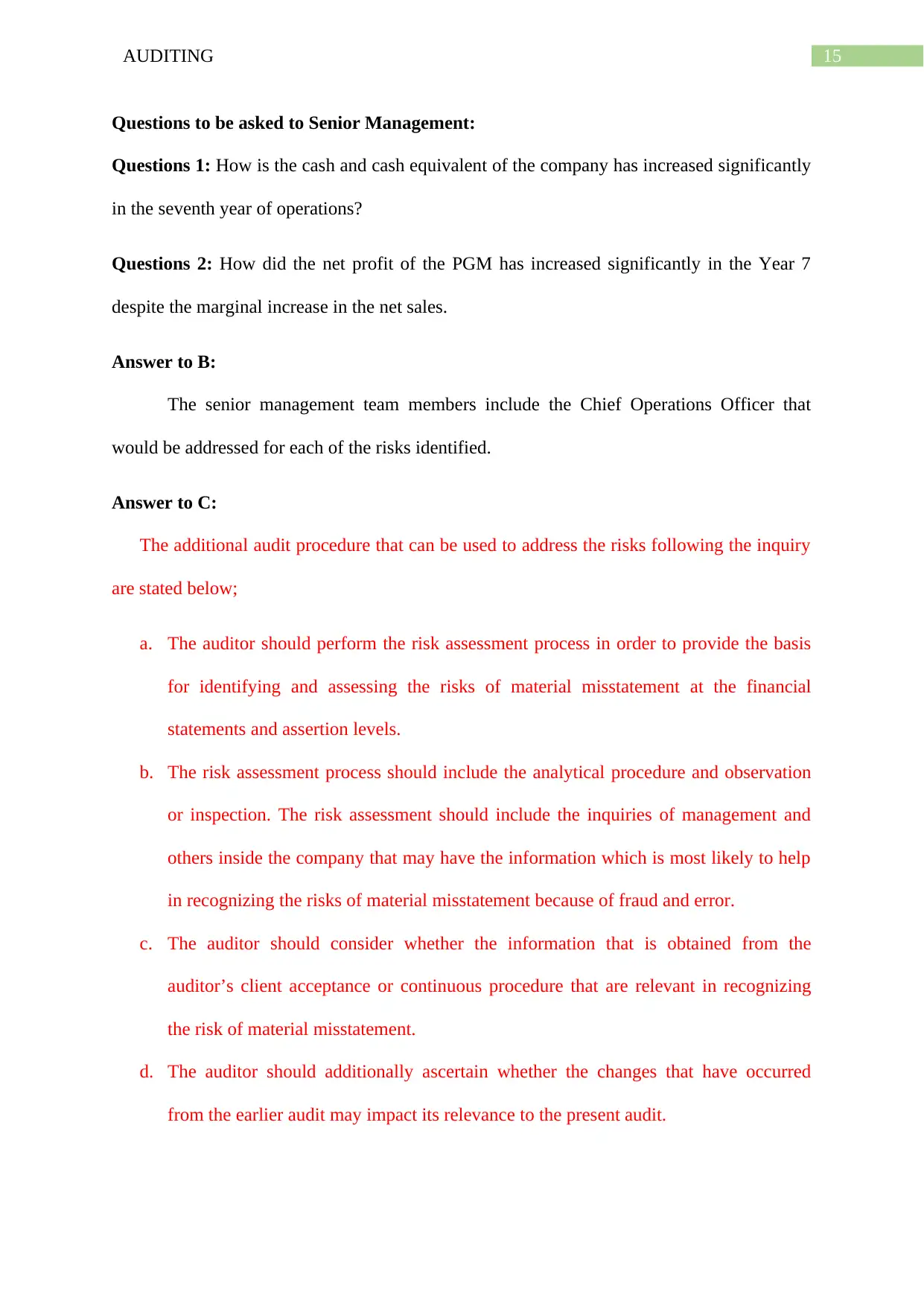
15AUDITING
Questions to be asked to Senior Management:
Questions 1: How is the cash and cash equivalent of the company has increased significantly
in the seventh year of operations?
Questions 2: How did the net profit of the PGM has increased significantly in the Year 7
despite the marginal increase in the net sales.
Answer to B:
The senior management team members include the Chief Operations Officer that
would be addressed for each of the risks identified.
Answer to C:
The additional audit procedure that can be used to address the risks following the inquiry
are stated below;
a. The auditor should perform the risk assessment process in order to provide the basis
for identifying and assessing the risks of material misstatement at the financial
statements and assertion levels.
b. The risk assessment process should include the analytical procedure and observation
or inspection. The risk assessment should include the inquiries of management and
others inside the company that may have the information which is most likely to help
in recognizing the risks of material misstatement because of fraud and error.
c. The auditor should consider whether the information that is obtained from the
auditor’s client acceptance or continuous procedure that are relevant in recognizing
the risk of material misstatement.
d. The auditor should additionally ascertain whether the changes that have occurred
from the earlier audit may impact its relevance to the present audit.
Questions to be asked to Senior Management:
Questions 1: How is the cash and cash equivalent of the company has increased significantly
in the seventh year of operations?
Questions 2: How did the net profit of the PGM has increased significantly in the Year 7
despite the marginal increase in the net sales.
Answer to B:
The senior management team members include the Chief Operations Officer that
would be addressed for each of the risks identified.
Answer to C:
The additional audit procedure that can be used to address the risks following the inquiry
are stated below;
a. The auditor should perform the risk assessment process in order to provide the basis
for identifying and assessing the risks of material misstatement at the financial
statements and assertion levels.
b. The risk assessment process should include the analytical procedure and observation
or inspection. The risk assessment should include the inquiries of management and
others inside the company that may have the information which is most likely to help
in recognizing the risks of material misstatement because of fraud and error.
c. The auditor should consider whether the information that is obtained from the
auditor’s client acceptance or continuous procedure that are relevant in recognizing
the risk of material misstatement.
d. The auditor should additionally ascertain whether the changes that have occurred
from the earlier audit may impact its relevance to the present audit.
Paraphrase This Document
Need a fresh take? Get an instant paraphrase of this document with our AI Paraphraser
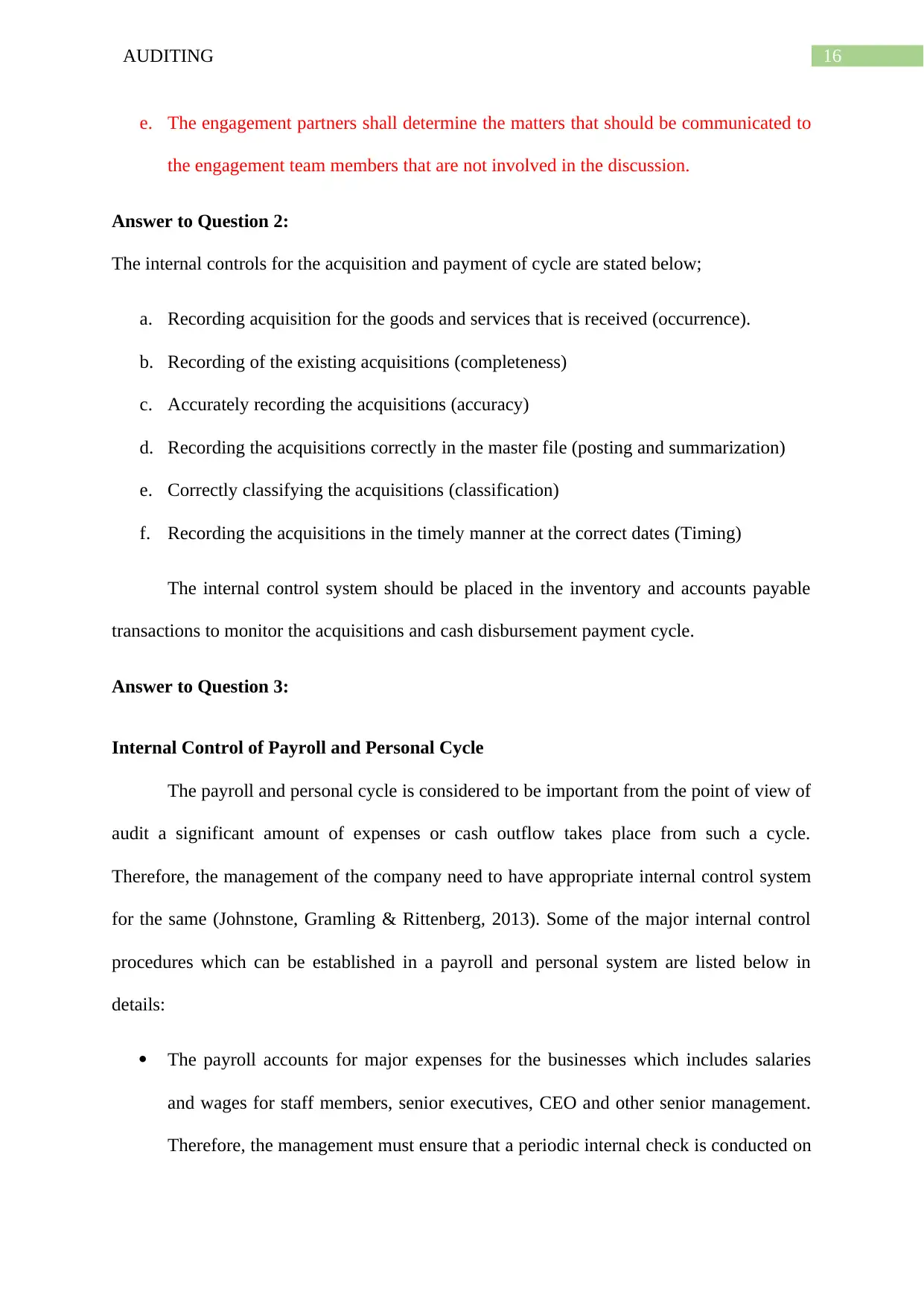
16AUDITING
e. The engagement partners shall determine the matters that should be communicated to
the engagement team members that are not involved in the discussion.
Answer to Question 2:
The internal controls for the acquisition and payment of cycle are stated below;
a. Recording acquisition for the goods and services that is received (occurrence).
b. Recording of the existing acquisitions (completeness)
c. Accurately recording the acquisitions (accuracy)
d. Recording the acquisitions correctly in the master file (posting and summarization)
e. Correctly classifying the acquisitions (classification)
f. Recording the acquisitions in the timely manner at the correct dates (Timing)
The internal control system should be placed in the inventory and accounts payable
transactions to monitor the acquisitions and cash disbursement payment cycle.
Answer to Question 3:
Internal Control of Payroll and Personal Cycle
The payroll and personal cycle is considered to be important from the point of view of
audit a significant amount of expenses or cash outflow takes place from such a cycle.
Therefore, the management of the company need to have appropriate internal control system
for the same (Johnstone, Gramling & Rittenberg, 2013). Some of the major internal control
procedures which can be established in a payroll and personal system are listed below in
details:
The payroll accounts for major expenses for the businesses which includes salaries
and wages for staff members, senior executives, CEO and other senior management.
Therefore, the management must ensure that a periodic internal check is conducted on
e. The engagement partners shall determine the matters that should be communicated to
the engagement team members that are not involved in the discussion.
Answer to Question 2:
The internal controls for the acquisition and payment of cycle are stated below;
a. Recording acquisition for the goods and services that is received (occurrence).
b. Recording of the existing acquisitions (completeness)
c. Accurately recording the acquisitions (accuracy)
d. Recording the acquisitions correctly in the master file (posting and summarization)
e. Correctly classifying the acquisitions (classification)
f. Recording the acquisitions in the timely manner at the correct dates (Timing)
The internal control system should be placed in the inventory and accounts payable
transactions to monitor the acquisitions and cash disbursement payment cycle.
Answer to Question 3:
Internal Control of Payroll and Personal Cycle
The payroll and personal cycle is considered to be important from the point of view of
audit a significant amount of expenses or cash outflow takes place from such a cycle.
Therefore, the management of the company need to have appropriate internal control system
for the same (Johnstone, Gramling & Rittenberg, 2013). Some of the major internal control
procedures which can be established in a payroll and personal system are listed below in
details:
The payroll accounts for major expenses for the businesses which includes salaries
and wages for staff members, senior executives, CEO and other senior management.
Therefore, the management must ensure that a periodic internal check is conducted on

17AUDITING
the payroll system for the purpose of ascertaining that the payroll computations are
being done accurately or not (Thite & Sandhu, 2014).
The management must also ensure that timely records are maintained for any increase
for certain employees, or any deductions from wages for time to time. This would
help in the audit process as the same would be creating an audit trail.
In case payroll system of a business is computerised than the tracking log and all
other information for the same should be password protected. The tracking log can
check all changes made to payroll and immediately reveal any fraud if that is the case.
Restriction to access of payroll system should be imposed on employee and only a
selected few would have access to the same (Muhakanizi & Secretary, 2014). This
authorization would be rotated and will not be fixed on one person.
The internal controls relating to internal checks can be placed at the start of the payroll
cycle so that accurate computation of the sum which is payable to the employees can be
estimated. Maintenance of documents is also another step which can be taken at the
beginning of the system so that the same can be maintained. Tracking log maintenance and
authorization can be placed at the middle of the cycle.
Answer to question 4:
Internal Control of Inventory and Warehouse Cycle
The inventory of a business is important area of consideration as they are used for the
purpose of generating revenue for the business. The internal control procedure which can be
applied for the business are listed below in details:
The most basic control process is physical control of the inventory and keeping a
track of the inventory of the business by maintaining a proper journal, invoices, ledger
the payroll system for the purpose of ascertaining that the payroll computations are
being done accurately or not (Thite & Sandhu, 2014).
The management must also ensure that timely records are maintained for any increase
for certain employees, or any deductions from wages for time to time. This would
help in the audit process as the same would be creating an audit trail.
In case payroll system of a business is computerised than the tracking log and all
other information for the same should be password protected. The tracking log can
check all changes made to payroll and immediately reveal any fraud if that is the case.
Restriction to access of payroll system should be imposed on employee and only a
selected few would have access to the same (Muhakanizi & Secretary, 2014). This
authorization would be rotated and will not be fixed on one person.
The internal controls relating to internal checks can be placed at the start of the payroll
cycle so that accurate computation of the sum which is payable to the employees can be
estimated. Maintenance of documents is also another step which can be taken at the
beginning of the system so that the same can be maintained. Tracking log maintenance and
authorization can be placed at the middle of the cycle.
Answer to question 4:
Internal Control of Inventory and Warehouse Cycle
The inventory of a business is important area of consideration as they are used for the
purpose of generating revenue for the business. The internal control procedure which can be
applied for the business are listed below in details:
The most basic control process is physical control of the inventory and keeping a
track of the inventory of the business by maintaining a proper journal, invoices, ledger
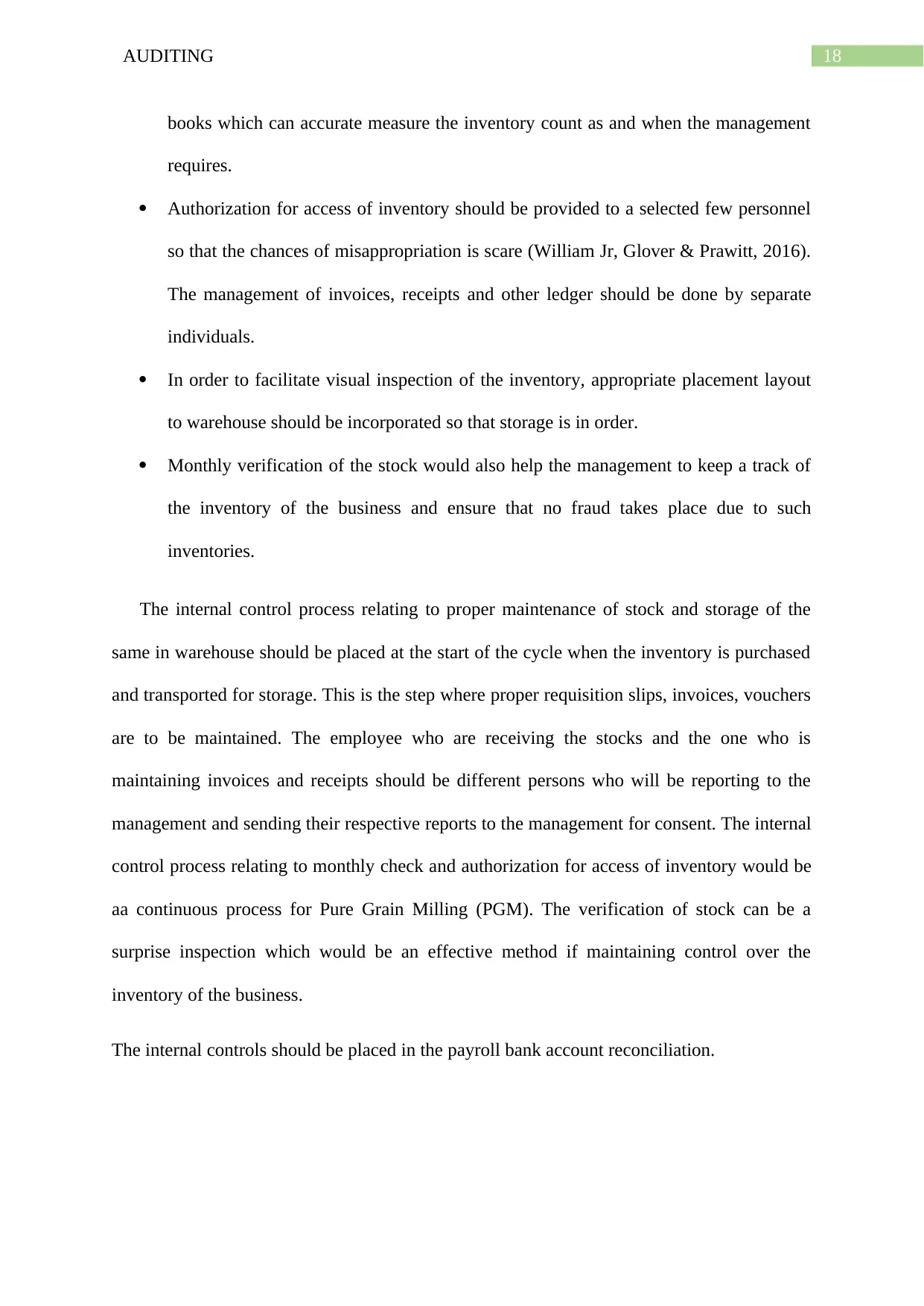
18AUDITING
books which can accurate measure the inventory count as and when the management
requires.
Authorization for access of inventory should be provided to a selected few personnel
so that the chances of misappropriation is scare (William Jr, Glover & Prawitt, 2016).
The management of invoices, receipts and other ledger should be done by separate
individuals.
In order to facilitate visual inspection of the inventory, appropriate placement layout
to warehouse should be incorporated so that storage is in order.
Monthly verification of the stock would also help the management to keep a track of
the inventory of the business and ensure that no fraud takes place due to such
inventories.
The internal control process relating to proper maintenance of stock and storage of the
same in warehouse should be placed at the start of the cycle when the inventory is purchased
and transported for storage. This is the step where proper requisition slips, invoices, vouchers
are to be maintained. The employee who are receiving the stocks and the one who is
maintaining invoices and receipts should be different persons who will be reporting to the
management and sending their respective reports to the management for consent. The internal
control process relating to monthly check and authorization for access of inventory would be
aa continuous process for Pure Grain Milling (PGM). The verification of stock can be a
surprise inspection which would be an effective method if maintaining control over the
inventory of the business.
The internal controls should be placed in the payroll bank account reconciliation.
books which can accurate measure the inventory count as and when the management
requires.
Authorization for access of inventory should be provided to a selected few personnel
so that the chances of misappropriation is scare (William Jr, Glover & Prawitt, 2016).
The management of invoices, receipts and other ledger should be done by separate
individuals.
In order to facilitate visual inspection of the inventory, appropriate placement layout
to warehouse should be incorporated so that storage is in order.
Monthly verification of the stock would also help the management to keep a track of
the inventory of the business and ensure that no fraud takes place due to such
inventories.
The internal control process relating to proper maintenance of stock and storage of the
same in warehouse should be placed at the start of the cycle when the inventory is purchased
and transported for storage. This is the step where proper requisition slips, invoices, vouchers
are to be maintained. The employee who are receiving the stocks and the one who is
maintaining invoices and receipts should be different persons who will be reporting to the
management and sending their respective reports to the management for consent. The internal
control process relating to monthly check and authorization for access of inventory would be
aa continuous process for Pure Grain Milling (PGM). The verification of stock can be a
surprise inspection which would be an effective method if maintaining control over the
inventory of the business.
The internal controls should be placed in the payroll bank account reconciliation.
Secure Best Marks with AI Grader
Need help grading? Try our AI Grader for instant feedback on your assignments.
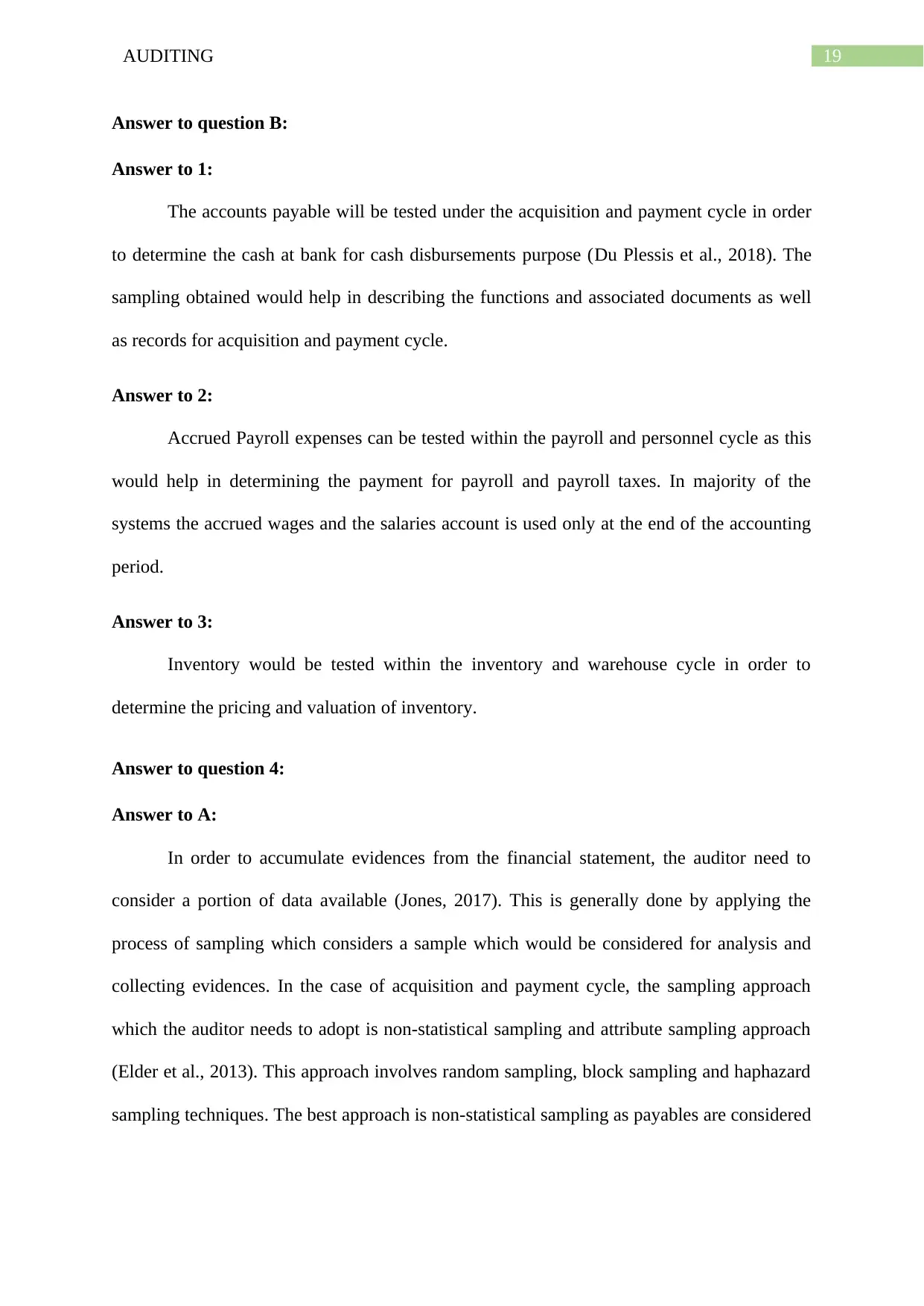
19AUDITING
Answer to question B:
Answer to 1:
The accounts payable will be tested under the acquisition and payment cycle in order
to determine the cash at bank for cash disbursements purpose (Du Plessis et al., 2018). The
sampling obtained would help in describing the functions and associated documents as well
as records for acquisition and payment cycle.
Answer to 2:
Accrued Payroll expenses can be tested within the payroll and personnel cycle as this
would help in determining the payment for payroll and payroll taxes. In majority of the
systems the accrued wages and the salaries account is used only at the end of the accounting
period.
Answer to 3:
Inventory would be tested within the inventory and warehouse cycle in order to
determine the pricing and valuation of inventory.
Answer to question 4:
Answer to A:
In order to accumulate evidences from the financial statement, the auditor need to
consider a portion of data available (Jones, 2017). This is generally done by applying the
process of sampling which considers a sample which would be considered for analysis and
collecting evidences. In the case of acquisition and payment cycle, the sampling approach
which the auditor needs to adopt is non-statistical sampling and attribute sampling approach
(Elder et al., 2013). This approach involves random sampling, block sampling and haphazard
sampling techniques. The best approach is non-statistical sampling as payables are considered
Answer to question B:
Answer to 1:
The accounts payable will be tested under the acquisition and payment cycle in order
to determine the cash at bank for cash disbursements purpose (Du Plessis et al., 2018). The
sampling obtained would help in describing the functions and associated documents as well
as records for acquisition and payment cycle.
Answer to 2:
Accrued Payroll expenses can be tested within the payroll and personnel cycle as this
would help in determining the payment for payroll and payroll taxes. In majority of the
systems the accrued wages and the salaries account is used only at the end of the accounting
period.
Answer to 3:
Inventory would be tested within the inventory and warehouse cycle in order to
determine the pricing and valuation of inventory.
Answer to question 4:
Answer to A:
In order to accumulate evidences from the financial statement, the auditor need to
consider a portion of data available (Jones, 2017). This is generally done by applying the
process of sampling which considers a sample which would be considered for analysis and
collecting evidences. In the case of acquisition and payment cycle, the sampling approach
which the auditor needs to adopt is non-statistical sampling and attribute sampling approach
(Elder et al., 2013). This approach involves random sampling, block sampling and haphazard
sampling techniques. The best approach is non-statistical sampling as payables are considered
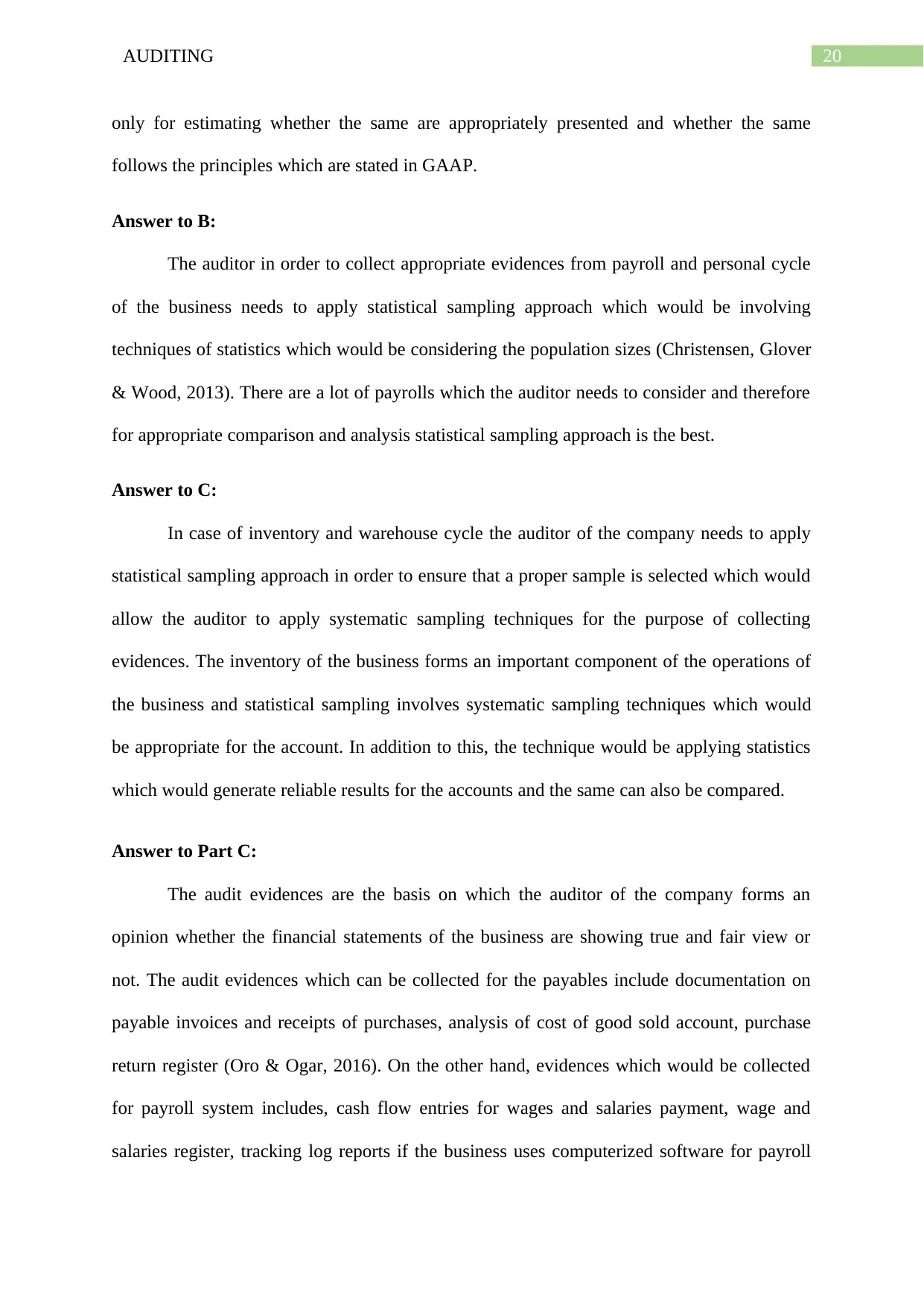
20AUDITING
only for estimating whether the same are appropriately presented and whether the same
follows the principles which are stated in GAAP.
Answer to B:
The auditor in order to collect appropriate evidences from payroll and personal cycle
of the business needs to apply statistical sampling approach which would be involving
techniques of statistics which would be considering the population sizes (Christensen, Glover
& Wood, 2013). There are a lot of payrolls which the auditor needs to consider and therefore
for appropriate comparison and analysis statistical sampling approach is the best.
Answer to C:
In case of inventory and warehouse cycle the auditor of the company needs to apply
statistical sampling approach in order to ensure that a proper sample is selected which would
allow the auditor to apply systematic sampling techniques for the purpose of collecting
evidences. The inventory of the business forms an important component of the operations of
the business and statistical sampling involves systematic sampling techniques which would
be appropriate for the account. In addition to this, the technique would be applying statistics
which would generate reliable results for the accounts and the same can also be compared.
Answer to Part C:
The audit evidences are the basis on which the auditor of the company forms an
opinion whether the financial statements of the business are showing true and fair view or
not. The audit evidences which can be collected for the payables include documentation on
payable invoices and receipts of purchases, analysis of cost of good sold account, purchase
return register (Oro & Ogar, 2016). On the other hand, evidences which would be collected
for payroll system includes, cash flow entries for wages and salaries payment, wage and
salaries register, tracking log reports if the business uses computerized software for payroll
only for estimating whether the same are appropriately presented and whether the same
follows the principles which are stated in GAAP.
Answer to B:
The auditor in order to collect appropriate evidences from payroll and personal cycle
of the business needs to apply statistical sampling approach which would be involving
techniques of statistics which would be considering the population sizes (Christensen, Glover
& Wood, 2013). There are a lot of payrolls which the auditor needs to consider and therefore
for appropriate comparison and analysis statistical sampling approach is the best.
Answer to C:
In case of inventory and warehouse cycle the auditor of the company needs to apply
statistical sampling approach in order to ensure that a proper sample is selected which would
allow the auditor to apply systematic sampling techniques for the purpose of collecting
evidences. The inventory of the business forms an important component of the operations of
the business and statistical sampling involves systematic sampling techniques which would
be appropriate for the account. In addition to this, the technique would be applying statistics
which would generate reliable results for the accounts and the same can also be compared.
Answer to Part C:
The audit evidences are the basis on which the auditor of the company forms an
opinion whether the financial statements of the business are showing true and fair view or
not. The audit evidences which can be collected for the payables include documentation on
payable invoices and receipts of purchases, analysis of cost of good sold account, purchase
return register (Oro & Ogar, 2016). On the other hand, evidences which would be collected
for payroll system includes, cash flow entries for wages and salaries payment, wage and
salaries register, tracking log reports if the business uses computerized software for payroll
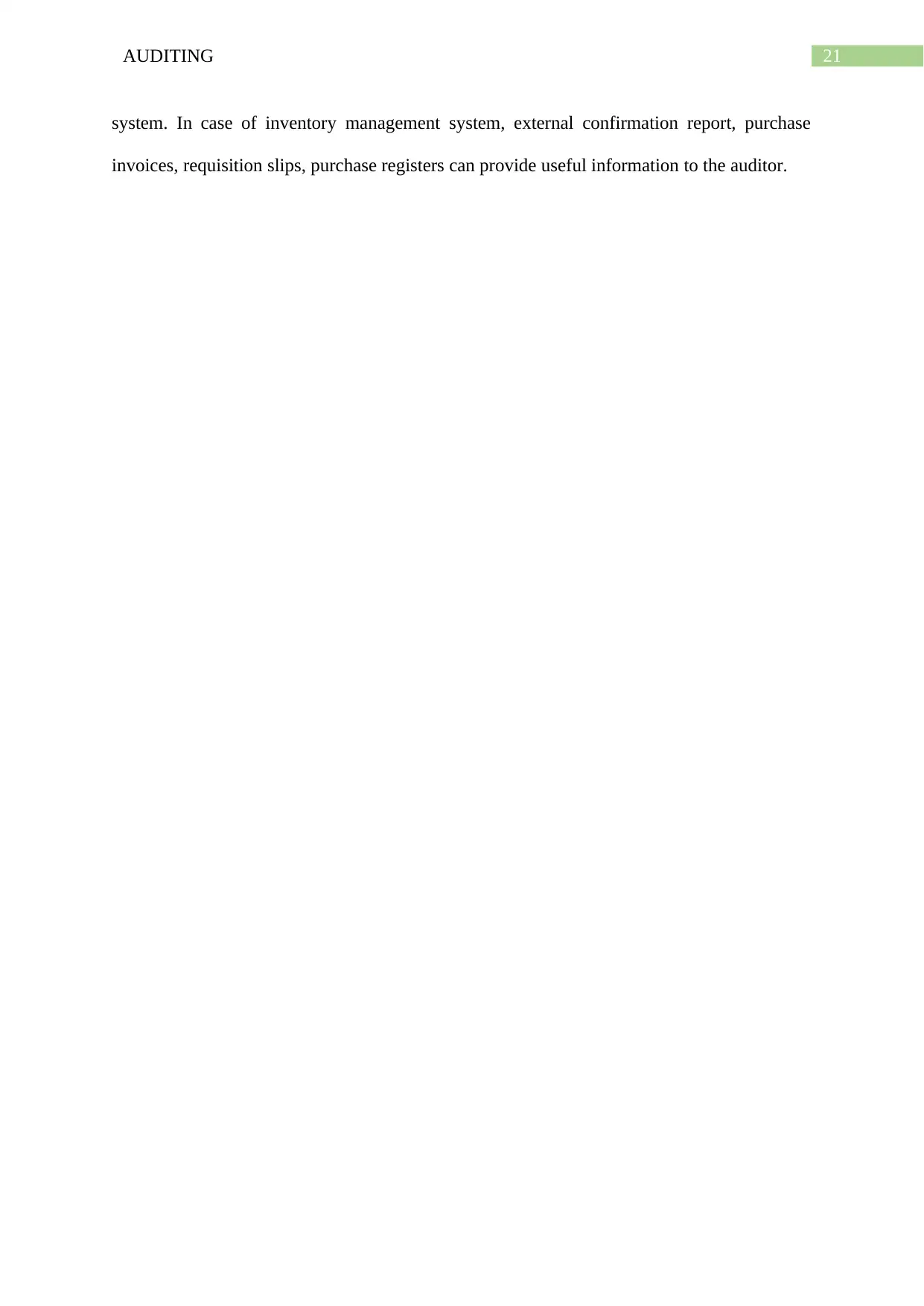
21AUDITING
system. In case of inventory management system, external confirmation report, purchase
invoices, requisition slips, purchase registers can provide useful information to the auditor.
system. In case of inventory management system, external confirmation report, purchase
invoices, requisition slips, purchase registers can provide useful information to the auditor.
Paraphrase This Document
Need a fresh take? Get an instant paraphrase of this document with our AI Paraphraser
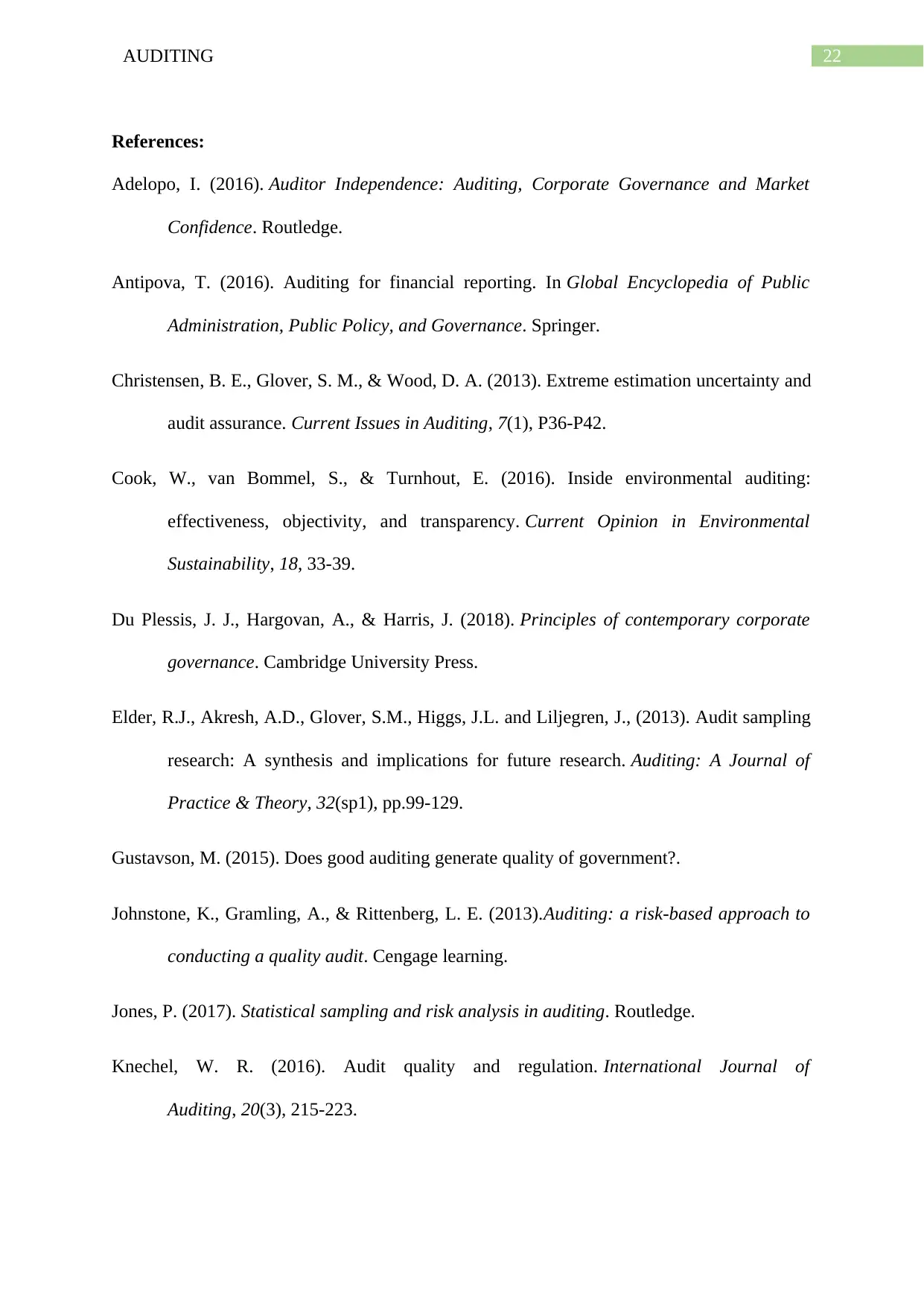
22AUDITING
References:
Adelopo, I. (2016). Auditor Independence: Auditing, Corporate Governance and Market
Confidence. Routledge.
Antipova, T. (2016). Auditing for financial reporting. In Global Encyclopedia of Public
Administration, Public Policy, and Governance. Springer.
Christensen, B. E., Glover, S. M., & Wood, D. A. (2013). Extreme estimation uncertainty and
audit assurance. Current Issues in Auditing, 7(1), P36-P42.
Cook, W., van Bommel, S., & Turnhout, E. (2016). Inside environmental auditing:
effectiveness, objectivity, and transparency. Current Opinion in Environmental
Sustainability, 18, 33-39.
Du Plessis, J. J., Hargovan, A., & Harris, J. (2018). Principles of contemporary corporate
governance. Cambridge University Press.
Elder, R.J., Akresh, A.D., Glover, S.M., Higgs, J.L. and Liljegren, J., (2013). Audit sampling
research: A synthesis and implications for future research. Auditing: A Journal of
Practice & Theory, 32(sp1), pp.99-129.
Gustavson, M. (2015). Does good auditing generate quality of government?.
Johnstone, K., Gramling, A., & Rittenberg, L. E. (2013).Auditing: a risk-based approach to
conducting a quality audit. Cengage learning.
Jones, P. (2017). Statistical sampling and risk analysis in auditing. Routledge.
Knechel, W. R. (2016). Audit quality and regulation. International Journal of
Auditing, 20(3), 215-223.
References:
Adelopo, I. (2016). Auditor Independence: Auditing, Corporate Governance and Market
Confidence. Routledge.
Antipova, T. (2016). Auditing for financial reporting. In Global Encyclopedia of Public
Administration, Public Policy, and Governance. Springer.
Christensen, B. E., Glover, S. M., & Wood, D. A. (2013). Extreme estimation uncertainty and
audit assurance. Current Issues in Auditing, 7(1), P36-P42.
Cook, W., van Bommel, S., & Turnhout, E. (2016). Inside environmental auditing:
effectiveness, objectivity, and transparency. Current Opinion in Environmental
Sustainability, 18, 33-39.
Du Plessis, J. J., Hargovan, A., & Harris, J. (2018). Principles of contemporary corporate
governance. Cambridge University Press.
Elder, R.J., Akresh, A.D., Glover, S.M., Higgs, J.L. and Liljegren, J., (2013). Audit sampling
research: A synthesis and implications for future research. Auditing: A Journal of
Practice & Theory, 32(sp1), pp.99-129.
Gustavson, M. (2015). Does good auditing generate quality of government?.
Johnstone, K., Gramling, A., & Rittenberg, L. E. (2013).Auditing: a risk-based approach to
conducting a quality audit. Cengage learning.
Jones, P. (2017). Statistical sampling and risk analysis in auditing. Routledge.
Knechel, W. R. (2016). Audit quality and regulation. International Journal of
Auditing, 20(3), 215-223.

23AUDITING
Kotb, A., Abdel-Kader, M. G., Allam, A., & Franklin, E. (2018). IT in Accounting and
Auditing Recommended Textbooks. Available at SSRN 3252371.
Kowaleski, Z. T., Mayhew, B. W., & Tegeler, A. C. (2018). The impact of consulting
services on audit quality: An experimental approach. Journal of Accounting
Research, 56(2), 673-711.
Kumar, R., & Sharma, V. (2015). Auditing: Principles and practice. PHI Learning Pvt. Ltd.
Marques, R. P., Santos, H., & Santos, C. (2016). Evaluating information systems with
continuous assurance services. International Journal of Information Systems in the
Service Sector (IJISSS), 8(3), 1-15.
Messier Jr, W. (2016). Auditing & assurance services: A systematic approach. McGraw-Hill
Higher Education.
Muhakanizi, K., & Secretary, P. (2014). Strengthening Public Financial Management and
Accountability. Ministry of Finance, Planning and Economic Development, 1-13.
Murdock, H. (2016). Operational auditing: Principles and techniques for a changing world.
Auerbach Publications.
Oro, B. L., & Ogar, G. U. (2016). Treasury Single Account (TSA), Integrated Payroll and
Personnel Information System (IPPIS), and Integrated Financial Management
Information System (IFMIS): Applicability and Implementability Effect ON Fraud
Management in the Public Sector. In MSc Seminar Department of Accounting
University of Calabar.
Simnett, R., Carson, E., & Vanstraelen, A. (2016). International archival auditing and
assurance research: Trends, methodological issues, and opportunities. Auditing: A
Journal of Practice & Theory, 35(3), 1-32.
Kotb, A., Abdel-Kader, M. G., Allam, A., & Franklin, E. (2018). IT in Accounting and
Auditing Recommended Textbooks. Available at SSRN 3252371.
Kowaleski, Z. T., Mayhew, B. W., & Tegeler, A. C. (2018). The impact of consulting
services on audit quality: An experimental approach. Journal of Accounting
Research, 56(2), 673-711.
Kumar, R., & Sharma, V. (2015). Auditing: Principles and practice. PHI Learning Pvt. Ltd.
Marques, R. P., Santos, H., & Santos, C. (2016). Evaluating information systems with
continuous assurance services. International Journal of Information Systems in the
Service Sector (IJISSS), 8(3), 1-15.
Messier Jr, W. (2016). Auditing & assurance services: A systematic approach. McGraw-Hill
Higher Education.
Muhakanizi, K., & Secretary, P. (2014). Strengthening Public Financial Management and
Accountability. Ministry of Finance, Planning and Economic Development, 1-13.
Murdock, H. (2016). Operational auditing: Principles and techniques for a changing world.
Auerbach Publications.
Oro, B. L., & Ogar, G. U. (2016). Treasury Single Account (TSA), Integrated Payroll and
Personnel Information System (IPPIS), and Integrated Financial Management
Information System (IFMIS): Applicability and Implementability Effect ON Fraud
Management in the Public Sector. In MSc Seminar Department of Accounting
University of Calabar.
Simnett, R., Carson, E., & Vanstraelen, A. (2016). International archival auditing and
assurance research: Trends, methodological issues, and opportunities. Auditing: A
Journal of Practice & Theory, 35(3), 1-32.
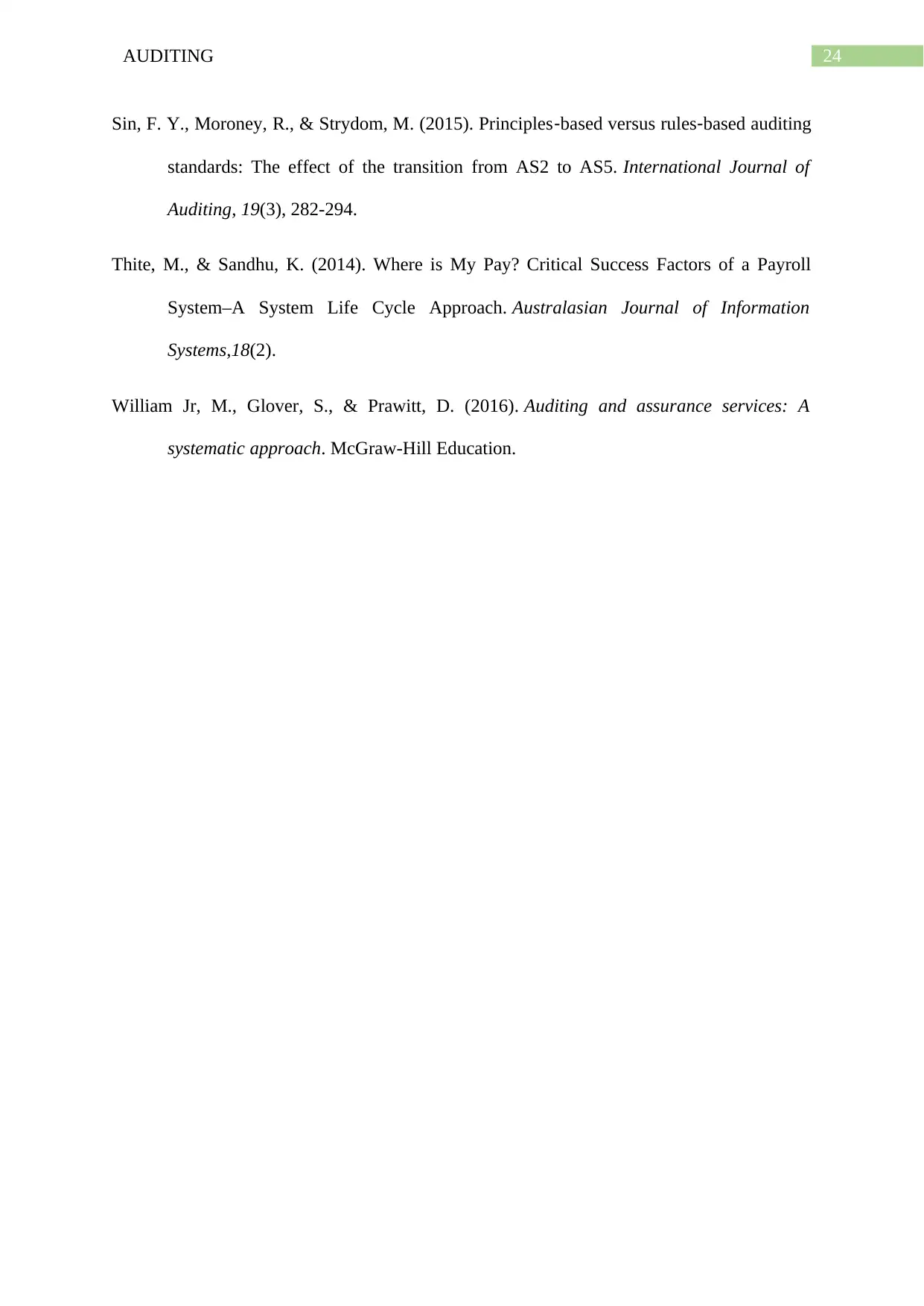
24AUDITING
Sin, F. Y., Moroney, R., & Strydom, M. (2015). Principles‐based versus rules‐based auditing
standards: The effect of the transition from AS2 to AS5. International Journal of
Auditing, 19(3), 282-294.
Thite, M., & Sandhu, K. (2014). Where is My Pay? Critical Success Factors of a Payroll
System–A System Life Cycle Approach. Australasian Journal of Information
Systems,18(2).
William Jr, M., Glover, S., & Prawitt, D. (2016). Auditing and assurance services: A
systematic approach. McGraw-Hill Education.
Sin, F. Y., Moroney, R., & Strydom, M. (2015). Principles‐based versus rules‐based auditing
standards: The effect of the transition from AS2 to AS5. International Journal of
Auditing, 19(3), 282-294.
Thite, M., & Sandhu, K. (2014). Where is My Pay? Critical Success Factors of a Payroll
System–A System Life Cycle Approach. Australasian Journal of Information
Systems,18(2).
William Jr, M., Glover, S., & Prawitt, D. (2016). Auditing and assurance services: A
systematic approach. McGraw-Hill Education.
1 out of 25
Related Documents
Your All-in-One AI-Powered Toolkit for Academic Success.
+13062052269
info@desklib.com
Available 24*7 on WhatsApp / Email
![[object Object]](/_next/static/media/star-bottom.7253800d.svg)
Unlock your academic potential
© 2024 | Zucol Services PVT LTD | All rights reserved.




